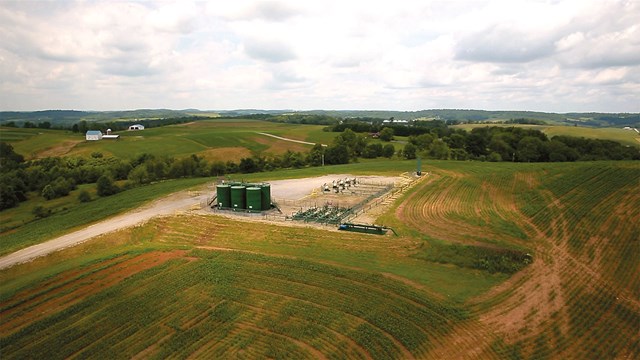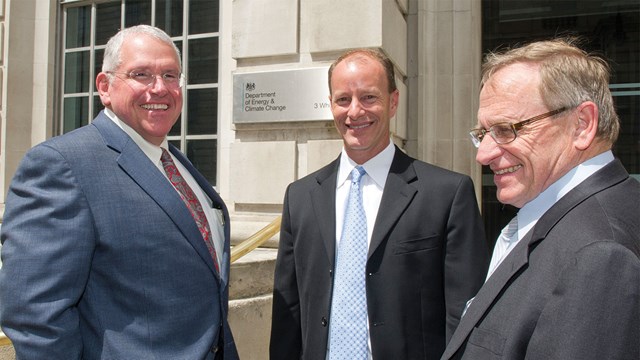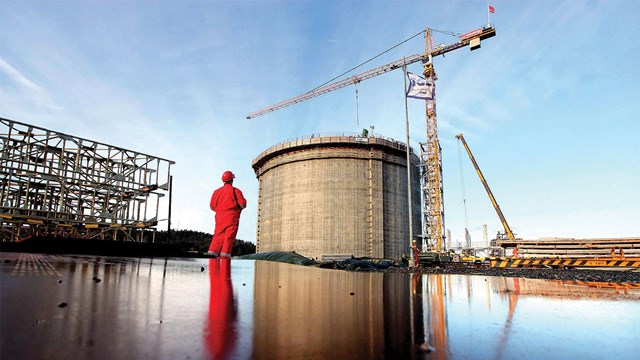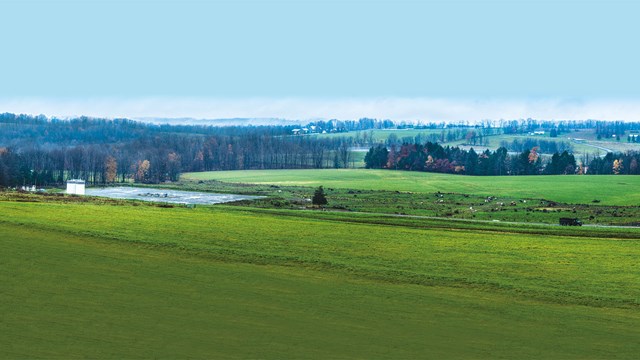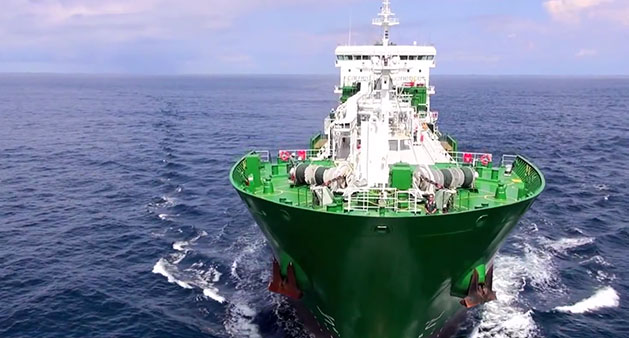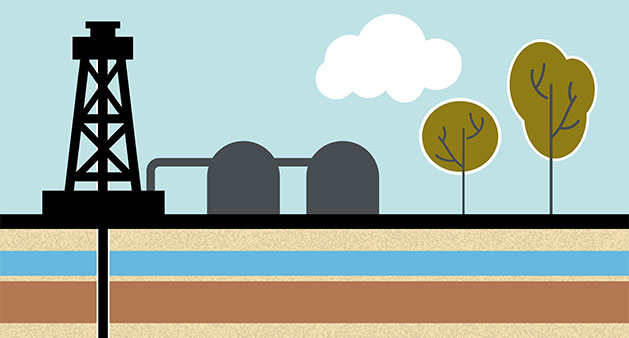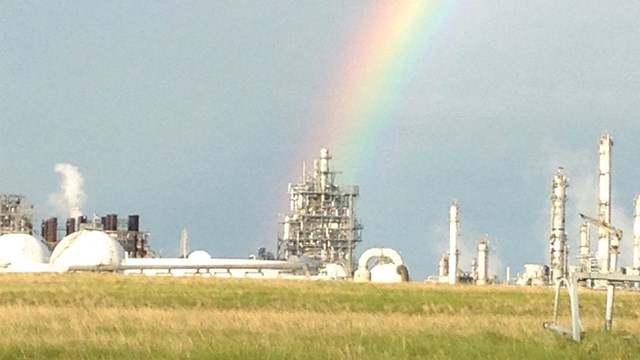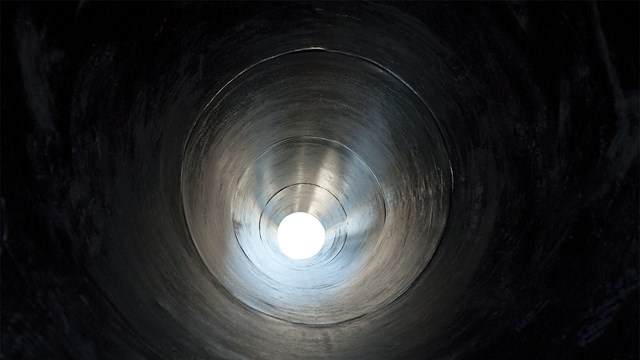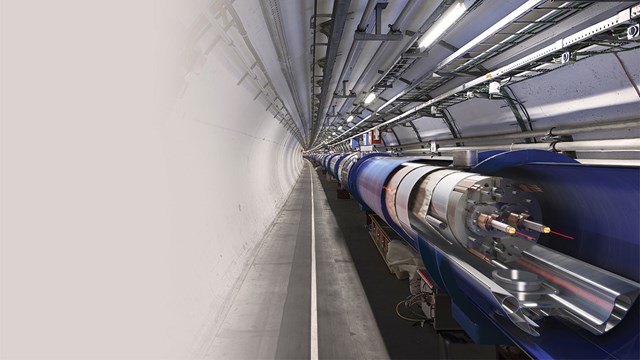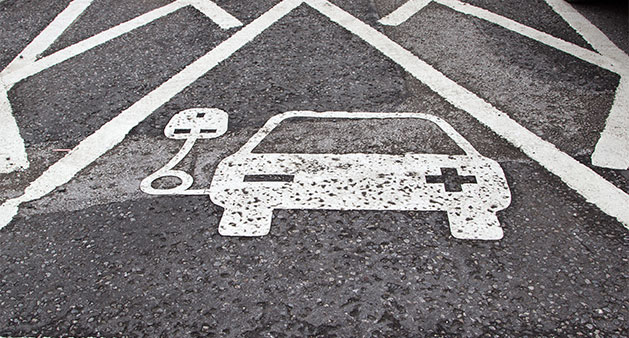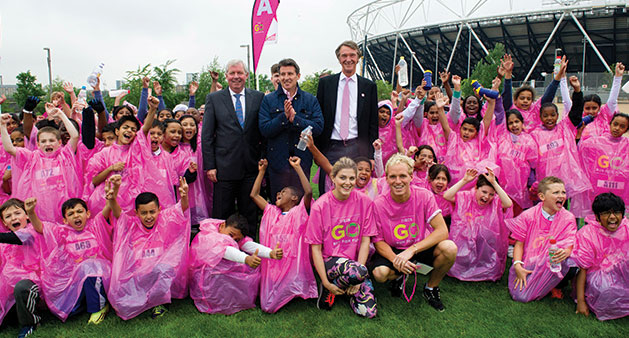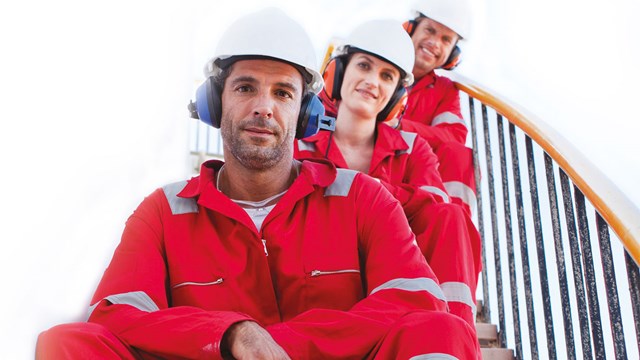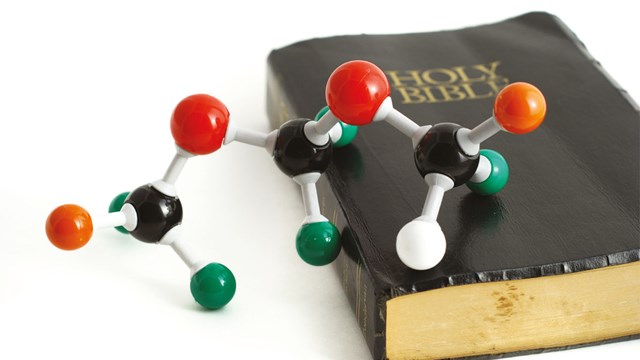Ineos' Pledge
INEOS promises to share shale gas revenues with communities
Also
-
Why Does It Matter
Search for Higgs boson has dominated careers of a generation of physicists
-
Rise Of The Drones
How unmanned aerial vehicles are gaining ground in the commercial world
-
Getting The Chemistry Right
How nations are working hard to sell science careers to young people
Scroll Down
-
Featured
Shale Gas: The Game-Changer?
Dwindling supplies of ethane gas from the North Sea has threatened the competitiveness of INEOS manufacturing units in Grangemouth (Scotland) and Rafnes (Norway).
In addition, across Europe, spiralling energy costs continue to threaten the very future of its petrochemical industry. The issue is widely acknowledged by those manufacturing businesses trying to compete in global markets. But as many wait for a political solution, INEOS is taking action, now, to protect its business before it is too late. From next year it will start shipping competitively-priced ethane from US shale gas to its gas crackers in Europe. Now it is looking longer term and is seeking to access indigenous gas from UK shale. Hydraulic fracturing has led to a manufacturing renaissance in America. It could do the same for the UK and Europe.
INEOS could soon be drilling for shale gas in a bold move that could help to safeguard the future of manufacturing in the UK and increase Britain’s energy security.
As Europe, which is now one of the most expensive places in the world to make petrochemicals, dithers over shale gas, INEOS has seized the initiative once again.
It has now acquired two licences to access indigenous gas from shale in Scotland. And although there is no activity at these sites yet, INEOS has already committed to full and open consultation with local communities and has also promised to share 6% of the revenue from its wells with homeowners, landowners and local authorities.
INEOS considers current arrangements with individuals and communities are not sufficiently equitable to convince the British people of the benefits of on-shore drilling for gas. But it believes a combination of community consultation and a fair share of the profits could lead to much greater understanding and acceptance of this important technology.
“We think our plan could be the game- changer for Britain,” said INEOS Chairman Jim Ratcliffe. “Giving 6% of revenues to those directly above shale gas wells means the rewards are fairly shared by everyone. It’s what they do in America and we think it is right to do this here because communities will have to put up with some inconvenience for about six months.”
INEOS believes it could eventually amount to more than £2.5 billion.
“That will make a substantial contribution towards new schools, parks, community centres and even hospitals,” said Jim. “It will be transformational for those communities. It will make a difference to their lives.”
The news was welcomed by the Country Land and Business Association which represents the interests of land and property owners in rural England and Wales.
“These proposals could help to speed up development of the industry which is important if shale gas is to contribute to the UK’s energy security and provide a bridging fuel to a low carbon economy as Government believes it can,” said association president Henry Robinson.
He said the association had consistently argued that the UK’s shale gas industry would be better served by giving landowners and communities an incentive.
“It seems only right that those whose property is drilled beneath feel some benefit from the process,” he said.
INEOS now has a stake in two exploration licences.
In August it bought BG Group’s 51% stake in the shale layer of an exploration licence (PEDL 133) which covers 329 square kilometres surrounding its Scottish refining and petrochemical plant at Grangemouth.
At the time Gary Haywood, CEO of INEOS Upstream, the company’s new oil and gas exploration and production business, hinted that INEOS was now well placed to become a major player in the UK on-shore gas production industry.
“We already have a large UK asset base, existing operating capabilities and an exemplary safety and environmental record, so this is a logical next step for INEOS,” he said.
In September INEOS, which is one of the very few companies that can use shale gas as both a fuel and a feedstock at its manufacturing plants, took another giant step in promising communities a share in the profits.
INEOS believes sharing revenues will give local people a real stake in the success of any venture.
Typically, those living in a shale gas community (approximately 100 square kilometers) would benefit from the output of 200 wells and split £375 million between them.
Home and landowners directly above the wells would share £250 million.
The rest of an INEOS shale gas community would share £125 million.
“Over the lifetime of a single well, home and land owners would get over £1.3 million and the community £600,000,” said Jim.
On October 13, INEOS announced it had signed an agreement with Reach Coal Seam Gas Limited to acquire an 80% stake in the exploration licence (PEDL 162) next to its first licence, in the central belt of Scotland, close to Grangemouth, which the British Geological Survey believes contains significant quantities of gas.
As part of the deal, INEOS will operate the licence and fund the initial activity on the site to determine whether the gas can be economically extracted.
“We are keen to move quickly to evaluate the potential of this resource,” said Gary. “If we can, it will provide a local source of competitive energy and raw materials to support manufacturing jobs in Scotland.”
INEOS is currently spending hundreds of millions of pounds to import large quantities of low-cost shale gas from America to Grangemouth to safeguard the future of its gas cracker in Scotland as the availability of gas in the North Sea dwindles.
But its decision to start drilling itself in the UK is a new – and exciting – venture.
The Institute of Directors believes that a UK shale gas industry could create 74,000 jobs and support many hundreds of thousands of manufacturing roles beyond this.
“UK shale has the potential to make up a significant proportion if not the totality of UK gas requirements going forward,” said Jim. “This would give the UK energy security for the first time in many years. It will help to protect manufacturing and jobs in Europe by securing competitive energy and raw materials and lead to a more competitive manufacturing sector. Our aim is simple – we hope to maintain and create jobs in Britain’s industrial heartlands.”
Shale gas also produces approximately half the greenhouse gas of coal and so has the potential to significantly reduce UK greenhouse gas emissions, as it already has in the USA.
INEOS has an exemplary safety and environmental track record at petrochemical plants. Its track record speaks for itself and when combined with the world’s leading experts in on-shore gas exploration and hydraulic fracturing , who are working exclusively for INEOS in Europe, people should become more confident in the compan’s ability to safely extract the gas.
Few companies in the UK have INEOS’ expertise or infrastructure to use and handle pressurised flammable gases safely.
Its experience above ground is widely acknowledged and over the past 12 months INEOS Upstream has been building up a team of world-leading experts in shale gas exploration and development to further strengthen its onshore gas credentials.
“It is extremely important that people know that shale gas can be extracted, transported and processed safely and in an environmentally responsible way,” said Jim. “INEOS is a company used to dealing with complex petrochemical processes so everything will be done to the highest possible standards.”
-
World-Leading Pioneers Join INEOS’ Team
The three world-leading experts, who are credited with perfecting shale gas extraction in America, are now working exclusively for INEOS in Europe.
Over the next five years petroleum engineer Nick Steinsberger and geologists Kent Bowker and Dan Steward will be advising INEOS how best to safely access Britain’s vast reserves.
All three worked for Mitchell Energy & Development, which pioneered the most effective method for safely extracting shale gas in the Barnett Shale in America and led to the development of the shale gas boom in US.
“They bring a vast experience of successful shale gas production,” said Gary Haywood, CEO of INEOS’ newly-formed shale team, INEOS Upstream. “We are confident that our US team, together with our own experts, can safely and efficiently develop a successful business in Scotland, which will play a part in securing the energy supply of Scotland and the UK, and will bring significant economic benefits to the country and to the community.”
Nick, Kent and Dan have been working in shale gas extraction since the 1980s and are regarded as leaders in their field.
Tom Crotty, INEOS Corporate Affairs Director, described Nick as the best on-shore gas petroleum engineer in the world.
“INEOS is one of the world’s biggest chemicals companies,” he said. “We are used to safely running huge petrochemical complexes. And now we have some of the world’s leading shale gas experts on our team who collectively have drilled thousands of wells. We believe that the combination of our expertise as a global petrochemicals company and their expertise in shale gas should begin to show people that we are committed to a very high safety standard and the responsible extraction of gas from shale.”
-
£230m Loan Guarantee Helps INEOS Raise Finance For Grangemouth's Future
For INEOS’ petrochemicals plant in Grangemouth, the good news continues.
Confirmation of a £230 million loan guarantee from the UK government this summer has now helped INEOS to raise the finance necessary to ensure INEOS O&P UK can build a tank to store imports of low-cost ethane from America – and turn its loss-making business into a profitable one.
Chief Financial Officer Gerry Hepburn said the government’s financial backing had been seen by INEOS as ‘critical’ to ensuring the long-term future of one of the largest manufacturing sites in the UK.
“The loan guarantee shows support for both the UK petrochemicals sector and for one of the most important infrastructure projects in Scotland,” he said. “We have now been able to use the loan guarantee to raise INEOS funds through a public bond issue. The proceeds of the bond are now being be used to fund the ethane tank project.”
INEOS has already invested more than £300million at its Grangemouth site as part of its long-term survival plan to ensure the site can manufacture petrochemicals beyond 2017 when its current gas supply agreements end.
Traditionally Grangemouth has relied heavily on ethane gas from the North Sea but those supplies are dwindling and the INEOS plant has been forced to run at reduced rates.
Importing ethane, which it uses as feedstock, from the US will help INEOS to return its plants to full production and improve operating costs, underpinning the future of manufacturing at Grangemouth.
“Without doubt, this is one of the most important projects of recent times in Scotland, with implications to be felt right across the UK, not only for employment but also for manufacturing in general,” said INEOS Chairman Jim Ratcliffe.
INEOS has hired Germany-based TGE Gas Engineering to build the ethane storage tank, which will be the largest in Europe and capable of storing 33,000 tons of ethane.
“The construction of the storage tank is complex and needs specialist knowledge,” said John McNally, CEO, O&P UK. “But we know we are working with a company that are truly leaders in their field.”
TGE built the INEOS ethylene import tank in Antwerp, Belgium, and are currently building the ethane import tank at INEOS’ plant at Rafnes in Norway.
Planning permission for the construction of the ethane tank at Grangemouth was granted by Falkirk Council in May this year.
“It will be very rewarding to see the renewal of the site starting to take shape as we begin construction work,” said Gerry.
Danny Alexander, Chief Secretary to the Treasury, said the Grangemouth guarantee was fantastic news for Scotland’s economic future, and for the UK’s energy security.
The amount of US ethane being imported will enable the ethylene cracker at Grangemouth to double production.
-
A Land Of Opportunity
Having already clinched game-changing, 15-year deals with America to import its low-cost, shale gas-based ethane, INEOS decided it was time to take a look at how the US did it and what lessons Europe could learn.
Ships, which the world has never seen before, leave America’s shores for the first time next year.
On board each vessel will be thousands of tons of liquefied ethane destined for INEOS’ gas crackers in Europe to help provide raw materials that are running out in the North Sea and to reduce the operating costs of its gas crackers.
Every day 40,000 barrels of shale gas-based ethane, which has been chilled to -140 degrees Fahrenheit, will leave Marcus Hook in Philadelphia for Norway and Scotland in the UK.
“Nobody has ever shipped ethane in these quantities around the world before,” said INEOS chairman Jim Ratcliffe. “These vessels have never been designed before and never crossed the North Atlantic before. This is a world first.”
INEOS needs ethane to make high value petrochemicals but if its businesses in Europe are to remain competitive, it must ship supplies from America, where there are sufficient quantities at competitive prices.
“We are effectively shipping US economics to Europe,” said Jim.
The state-of-the-art ships, currently being built in China, are highly efficient and will have double engines so they can operate in the harshest of conditions. Meanwhile INEOS is building new export facilities in the US and storage tanks at Rafnes and Grangemouth.
The journey across the Atlantic Ocean will begin at Marcus Hook, the site of a former crude oil refinery, which produced gasoline, diesel, and kerosene for more than a century. About 500 people lost their jobs when the loss-making plant was finally shut down in 2011 due to difficult market conditions. Today it is being transformed into a major centre for processing and shipping natural gas liquids thanks to its links with Pennsylvania’s Marcellus shale industry.
“It was a bit of disaster area,” said Tom Crotty, INEOS Corporate Affairs Director. “Much of that town was built around industry with businesses such as the refinery. Jobs depended on it. But suddenly this community, which thought it was dead on its feet, has been brought back to life again, thanks to shale gas.”
Marcus Hook is also where Jim and a team from INEOS began their recent, fact-finding tour of America. INEOS, which has invested in its own team of experts to weigh up the pros and cons of pursuing shale gas exploration in the UK, wanted to see – and understand – how it might work in Europe.
The group spent a day at Marcus Hook before visiting the Barnett shale field in Texas – home of the very first drilled horizontal well.
Explaining how it worked was Nick Steinsberger, described by Tom as the best on-shore gas petroleum engineer in the world.
“A lot of others had dabbled and given up, but Nick worked out how to fracture the rock,” said Tom. “He was the first to use what is called slick water hydraulic fracturing to crack open the Barnett shale field in Texas. He opened the door to the development worldwide. He made the breakthrough.”
Nick worked for Mitchell Energy & Development when with its founder George Mitchell. The company was sold for $3.5 billion in 2002. Today Nick runs his own business.
Nick later escorted INEOS’ delegation to south west Pennsylvania in the Marcellus shale, one of the largest natural gas reserves in the world.
“He wanted us to see it because it is similar to Europe with green, rolling countryside,” said Tom. “And now, there are also a lot of strict regulations in place.”
For Tom, it was an eye-opener.
“One of the public’s biggest concerns is the effect on the countryside,” said Tom. “I had imagined it would be like Texas with nodding donkeys all over the place but in the biggest shale gas area in America, you cannot see anything. There is nothing to be seen, and nothing to be heard. It is just bubbling away like a bottle of pop. The reality is that a single well takes three weeks to drill and one week to fracture, when there is a lot of activity on the site, and then that well can give you gas for anything between 20 and 50 years.”
The UK is currently the only country in the EU to seriously consider fracking.
Gary Haywood, who is leading INEOS’ shale gas project team, said the British Government had recognised that shale gas had the potential to provide the UK with greater energy security, growth and jobs.
“People want an affordable and reliable energy supply,” said Gary. “About 85% of UK homes rely upon gas for heating or cooking, and our indigenous UK supply has now dwindled to less than 50% of our demand. We have a clean energy resource in the UK shale that is ready for development, and this can bring a wide range of benefits to the country. INEOS is keen to be part of this development, and we will be pursuing sensible opportunities to develop shale gas for the company and for the country.”
There are currently more than 176 Petroleum Exploration Development Licences (PEDL) for onshore oil and gas in the UK. More on-shore licences were awarded this year.
Communities and landowners are being offered incentives to allow companies to drill, but INEOS says they do not go far enough.
“We think that communities should share in the benefits if gas is being supplied from under their land,” said Tom. “The offer of £100,000 is not enough to make people think that it’s a great idea so we have announced plans to give 6% of our shale gas revenues to homeowners, landowners and communities close to our wells. We estimate that we will give away over £2.5 billion from our new shale gas business.”
Opposition to fracking in the UK has deepened since the protests at Balcombe in West Sussex last year.
“The drilling in Balcombe provoked some emotional reactions,” said Tom. “But the issue is that people are not generally well informed about shale gas production. The ‘anti’ lobby have whipped up irrational fear of this technology, largely via misleading propaganda.”
Tom and his team are keen to do something about this.
“We’ve produced a short film that tells people the real facts around shale gas production. We want the public to hear the real story,” he said.
Tom says that the film debunks some of the myths around the impact of shale gas production, and also outlines the important benefits that the industry can bring to the UK.
“It is important that people are given all the facts and they can then make an informed decision,” said Tom. “The industry can bring much-needed jobs, and can secure the energy supply for the people of the UK via production of a clean fuel that has half the greenhouse gas impact as coal.”
The other big unknown is how continental Europe will respond.
“I am not sure how long they can ignore this issue,” said Tom. “Some believe the US has shot its bolt and the gas is going to be gone in a few years time but it won’t. We met companies in the US that had only so far drilled less than 10% of their acreage - there is a long-term industry and supply in place via shale gas production in the US. And renewables will not do the job. Gas is the perfect complement to renewable energy because you need a back up. If the wind does not blow, you cannot turn the fridge off.”
INEOS’ 15-year deals with America to import ethane are seen as a stop-gap while Europe makes up its mind.
“It buys us time,” said Tom. “It bridges us for the next 15 years until the point when we hope we are going to have an indigenous UK shale industry which can supply that ethane.”
-
Cracking Investment
Shale gas is driving investment in the US, and it shows no signs of letting up. The American Chemistry Council says US chemical investment linked to shale gas has now topped $100 billion. And INEOS is among those parting with their money.
INEOS has built one of the largest ethane-cracking furnaces in the world to take advantage of America’s low-cost shale gas.
It has invested $115 million in a new furnace at the 2,400-acre Chocolate Bayou Works manufacturing complex in Texas to produce competitive ethylene, a chemical that is used by manufacturers to make everything from soaps to paint to clothes to plastic bottles to cosmetics.
“This now means we won’t lose capacity every time we have to take down one of the other six furnaces to clean them,” said Dennis Seith, CEO INEOS Olefins & Polymers USA. “That, in turn, improves our overall reliability.”
INEOS now operates the second largest ethylene site in the US and the fifth largest in the world, and thanks to state-of-the-art technology, the new furnace has lower environmental impact.
“It produces lower emissions per ton of ethylene production and employs the best available industrial technology for emissions control in the industry today,” said Dennis.
INEOS began planning to build the furnace in mid-2011. It was started up in April this year, 28 months after the first construction contract with KBR was signed.
The project swallowed more than 564,000 construction man-hours – the equivalent of 60 years – during which time construction workers installed eight miles of new piping and 26 miles of new electrical and instrumentation cable.
“It was a tremendous result and one that was delivered safely,” said Dennis. “It also secures the future of our site for the next generation.”
The American Chemistry Council says US chemical investment linked to shale gas had now topped $100 billion.
As of February this year, 148 projects including new factories, expansions and process changes to increase capacity, had been announced.
“This is an historic milestone for America’s chemical industry and proof that shale gas is a powerful driver of manufacturing growth,” said ACC President and CEO Cal Dooley. “Thanks to the shale gas production boom, the United States is the most attractive place in the world to invest in chemical and plastics manufacturing. It’s an astonishing gain in competitiveness.”
INEOS’ new furnace will add up to $55 million profit to the bottom line every year.
“This has all been part of our plans to add capacity to take advantage of ethane produced from US shale gas and is consistent with our long-term strategy to improve site scale and ability to access low-cost ethane feedstock from shale gas,” said Dennis.
The good news for American investment, though, does not end there.
In August INEOS and Sasol finally reached an agreement to build a new plant together to produce 470,000 tons of high-density polyethylene a year at LaPorte, Texas.
The plant will be built at INEOS’ Battleground Manufacturing Complex and should be operational by 2016.
“This investment will allow INEOS to meet our customers’ needs for additional bimodal products,” said Dennis. “It also supports INEOS’ strategy to invest and to capture synergies on our major sites.”
The 50/50 joint venture, which was initially discussed by the two companies in July 2013, will use Innovene™ S process technology licensed from INEOS Technologies.
The ethylene needed for the production of the high-density polyethylene will be supplied by INEOS and Sasol in proportion to their respective ownership positions.
“This project will expand Sasol’s presence in the global chemical market and complement our North American growth strategy,” said Fleetwood Grobler, Sasol group executive for global chemicals. “Its location offers several benefits, including access to US Gulf Coast infrastructure and proximity to our proposed ethane cracker and derivatives complex in Southwest Louisiana.”
Access to vast new supplies of American natural gas from shale deposits is one of the most exciting domestic energy developments in decades, particularly
for the petrochemical industry.The International Energy Agency believes the US will be self-sufficient in natural gas production by 2015 and oil production by 2035.
And in May this year Energy in Depth said CO2 emissions in the United States were now at their lowest level for 20 years.
-
No Longer A Pipe Dream
Britain’s reliance on foreign imports of gas and coal hit an all-time high last year. And that dependency is set to increase. By 2020, Centrica, the parent company of British Gas, believes the UK will be importing 70% of the gas it needs.
For energy-hungry companies like INEOS, with manufacturing plants in the UK, that’s a major concern and one it can no longer ignore.
INEOS is planning to invest millions in creating opportunities for more underground gas storage facilities in the UK.
The decision – made by INEOS earlier this year – comes at a time of growing concern over spiralling energy costs in the UK, the security of Britain’s energy supplies and the nation’s increasing reliance on foreign imports.
Gas stored in the cavities at the Holford Brinefield in Cheshire will play a part in keeping the lights on in the UK and ultimately keep industrial consumers such as INEOS in business.
The benefits for INEOS, though, will actually be twofold.
“Even without gas storage, cavities would still be formed as they provide the brine that INEOS needs at its two sites in Runcorn,” said Richard Stevenson, Project Manager at INEOS Enterprises. “The proposed development would simply make use of the salt cavities once all the brine has been extracted.”
Controlled solution mining has taken place in the Holford Brinefield since the 1920s. Since that time, over 200 cavities have been safely mined by INEOS and its predecessors.
INEOS ChlorVinyls uses the concentrated salt solution to produce chlorine, which keeps most of the UK’s drinking water safe. INEOS Enterprises’ Salt Business also uses it to produce table salt, water softeners and de-icing salt.
If planning permission is granted, this would be the third gas storage project at the Holford Brinefield and would create an additional 19 gas storage cavities. Today, a significant number of cavities are in use for the production of brine, eleven are operational for gas storage with a further eighteen being developed for gas storage.
The importance of gas storage in the UK should not be underestimated.
Recently the Energy and Climate Change Committee called on the British Government to double the UK’s current gas storage by 2020.
As such, the proposed development at Holford has been classified as a Nationally Significant Infrastructure Project, which means – unlike most planning applications – it will not be decided by the local authority. Instead it requires a Development Consent Order from Ed Davey, the current Secretary of State for Energy & Climate Change.
INEOS and Keuper Gas Storage Limited, a wholly-owned subsidiary of INEOS Enterprises Group Limited, are expected to apply for that order early next year.
It is hoped Mr Davey will make a decision in 2016 so that construction can start the following year. INEOS would then expect to start storing natural gas in the specially-designed underground caverns from 2020.
“This is an important proposal for the UK’s energy security and would provide vital investment and jobs for Cheshire,” said Greg Stewart, INEOS Enterprises’ Operations Director. “It is also a significant investment, which can be delivered without subsidies from the Government.”
In March this year Centrica, the parent company of British Gas, warned that the UK would be importing up to 70% of its gas by 2020.
Chief executive Sam Laidlaw said Britain’s energy security supply risked becoming the ‘forgotten priority’ of European energy policy.
“In the UK an estimated 3.7 Gigawatts of coal-fired generating capacity will be shut down by the end of 2015 as a result of European directives to curb emissions,” he said. “The country’s reserve capacity is forecast to shrink to 4%, increasing the risk of power cuts. Yet no new capacity is being built. The UK’s production of gas is falling rapidly. North Sea oil and gas output has fallen by 38% over the past three years. By 2020 we will be reliant on imports to meet 70% of the country’s gas needs. So when it comes to security of supply, there is a pressing need for solutions.”
For a company like INEOS, which uses as much energy as the city of Liverpool to power its plants in Runcorn, it’s not a forgotten matter. It’s very much a priority.
The UK became a net importer of energy in 2004. In 2010 it was importing 28% of its supply. Last year it rose to 47% with exports at their lowest level since 1980.
Successful development of this project, along with the previous two INEOS supported gas projects in Cheshire, would have a combined ability to deliver up to 40% of the UK’s daily gas storage capability.
“If there were a major supply disruption to the UK, the gas stored on the INEOS Enterprises Brinefield, including this project, could help to keep the lights on in the UK for nearly two weeks,” said Richard.Gas from the National Transmission System would be stored in the cavities when demand is low, usually during the warmer, summer months. When the demand increases, it will be fed back into the UK’s National Transmission System.
Cheshire is one of the few places in the UK where gas can be safely stored underground due to the geology. The salt stratum is impermeable which means gas cannot pass through it.
For more details log on to www.kgsp.co.uk
-
Why Does It Matter
The discovery of the Higgs boson particle, which gives substance to everything in the universe, turned physicists into rock stars for a day. It had been spectacularly difficult to find but a generation of physicists were so convinced that it was out there – somewhere – that they persuaded 40 countries from around the world to create the most complex machine ever built to test the theory.
But what about the rest of us? Were we actually bothered? Should we care? And why does this discovery matter? INCH went to CERN, close to the INEOS headquarters and listened to some of the scientists involved.
It was one of the biggest scientific discoveries of all time.
Many physicists, whose careers had been dominated by the search for the elusive Higgs boson, thought they might never live to see it.
But the average man, woman and child in the street are still probably wondering what the discovery of the Higgs boson particle has got to do with them, and whether it was worth the £6 billion spent trying to find it, especially in the midst of a global recession.
It’s a question that Ainissa Ramirez, a former associate professor of mechanical engineering and materials science at America’s Yale University, understands.
“This discovery is up there with Copernicus,” she said. “But people don’t want to know the details of the Higgs. Not yet. They want to know why it is important and how this changes human history.”
One thing is certain. It will shape our world. We just don’t know quite how yet.
“I cannot promise that the discovery of the Higgs particle will lead to a new type of non-stick pan, or any other concrete change to daily activities,” said Professor Dave Charlton, scientific leader of the ATLAS experiment at CERN which discovered the particle. “It probably won’t. But I hope the person in the street shares the common goal of many people to understand more about the way things work. Pushing the boundaries towards the deep building blocks of the universe is surely a cultural as well as a scientific imperative.”
Professor Charlton, who is also a professor of particle physics at the University of Birmingham in the UK, said it was difficult to compare the Higgs discovery with previous historical discoveries, like radioactivity or the structure of DNA.
“It’s just too early,” he said. “It can take decades or longer to figure out how such new physics will work through into new technologies. We don’t know what the consequences will be in terms of the next scientific steps. But we do know we have just taken a very big step in establishing how particles can have mass.”
To discover the Higgs boson – the particle that gives mass to everything we see and arguably the most coveted prize in physics – scientists needed to recreate conditions less than a billionth of a second after the Big Bang 13.7 billion years ago. And to do this, they needed to build the most complex machine that had ever been built.
For 15 years more than 10,000 scientists from 40 countries invested their time and expertise in creating an atom-smasher in a near circular 27km-long tunnel 100 metres (325ft) underground near Geneva, Switzerland.
Professor Sir Jim Virdee, from London’s Imperial College, said some of the technology did not even exist when they started designing the Large Hadron Collider (LHC) which would accelerate sub-atomic particles to almost the speed of light and then smash them together.
But the discovery of the Higgs boson in July 2012 – and confirmed in March this year – finally showed the world what theoretical physicists Peter Higgs, Robert Brout and François Englert had predicted almost 50 years earlier. Looking into the future, it may solve fundamental questions about the origin of the universe, and, perhaps more importantly, its fate.
“We have answered one deep and long-standing puzzle,” said Professor Charlton. “But the discovery has also posed more questions than it has answered. Some of these questions are not new but they are crystallised into real problems by the discovery. They are no longer hypothetical problems.”
Ms Ramirez said when the electron was discovered in 1897, its uses were not obvious. “What is obvious today is that we can’t live without electrons, since they run through all our electronics,” she said.
CERN, the European Organisation for Nuclear Research, was founded in 1954. Its mission was – and still is – to advance the frontiers of technology, find answers to questions about the universe, bring together nations through science and train the scientists and engineers of tomorrow.
“Understanding the world around us has been a basic human interest from time immemorial,” said Professor Charlton. “People work together at CERN irrespective of nationality, gender, religion or other distinctions, because we all want answers to these basic questions.”
Over the years thousands of scientists and physicists have passed through the doors.
When the LHC was switched on in September 2008 to global fanfare, scientists were venturing into the unknown.
The machine in their midst was capable of producing enough data to fill 100,000 CDs every second. The challenge would be to find a way to sift through that data to find the only standard model particle that had never been seen.
Every second there were about 800 million head-on collisions at almost the speed of light. If scientists had recorded all the data, it would have been like trying to make 50 billion telephone calls all at the same time or listen to songs for 600 years.
“Just a fraction of those collisions were of interest so we had to cut it down very quickly to the most interesting events,” said Professor Charlton.
Initially there were teething problems. Thirty six hours after the LHC had been switched on, it had to be shut down again due to a faulty electrical wire between two magnets which had been melted by the high current passing through it.
The LHC was finally restarted in November 2009 after repairs and the installation of a new safety system.
Life without the Higgs Boson would not be life as we know it. Particles would have continued to fly through the universe, never clumping together to form anything.
“It is astounding that we understand only a small fraction of the stuff in the universe,” said Professor Charlton. “The next data we take at the LHC could give us deep insights into the dark universe (dark matter) that we do not understand.”
The LHC was shut down in February last year for a massive upgrade. When it restarts in January physicists can only imagine what they might find.
All they know is this is just the beginning.
“There are still many mysteries there,” said Professor Charlton. “We do know now, though, that empty space is not as we had thought. Empty space contains something, an invisible “Higgs field”, which all particles interact with. The discovery of the Higgs boson is a big step forward in our understanding of the deepest structure of nature.”
As a professor of particle physics, probing deep into the basic structure of matter and forces, he believes nothing is impossible.
“All scientific problems can be attacked,” he said. “Sometimes they may take years or decades to solve, but it should be possible to find answers to how things work. Understanding each new puzzle just takes time and energy and people and money.”
Meanwhile, as a major, international laboratory, CERN has now set its sights on something even bigger.
It wants to build a new underground machine that would be four times the size of the LHC. The 100km tunnel, which would encircle all of Geneva, would have unparalleled energy levels.
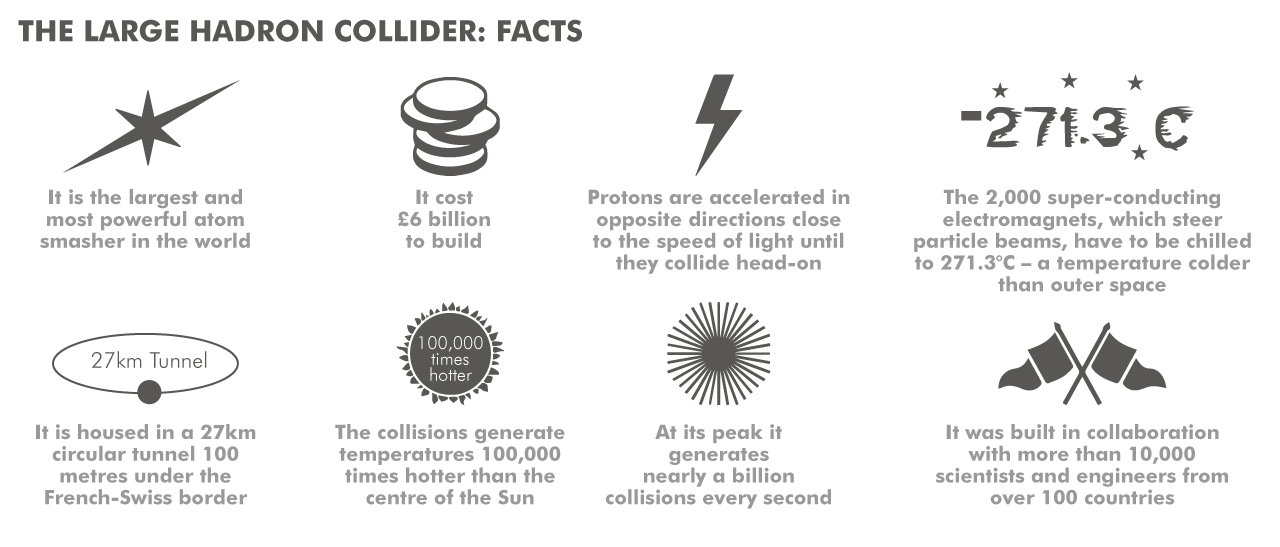
-
CERN Finds Its Place In History
Key technologies developed at CERN over the past 60 years have been finding their way into the outside world – and benefiting society.
So far, The European Organisation for Nuclear Research can be thanked for giving the world more efficient solar panels, the World Wide Web, touch screen technology and medical imaging to name but a few.
“The common drive for knowledge pushes us continuously to look for, and often develop, innovative technologies which are useful to us, as well as to others,” said Professor Dave Charlton.
You would assume CERN has always benefited financially through patenting such inventions. But it hasn’t - due to the highly collaborative way it works.
As one of Europe’s first joint ventures, its member states pump in millions of euros into the organisation every year to help develop new technologies which means they don’t want to then have to pay to use the inventions in their own countries.
In the past CERN simply published details of its inventions in the same way it published its scientific discoveries. In other words, they were freely available.
In 2010, though, CERN signed an agreement with the United Nations’ World Intellectual Property Organization (WIPO) to ensure it benefited from its engineers’ innovations.
“Basic science is the driving force for innovation,” said CERN director General Rolf Heuer. “It is therefore vital for organisations like CERN to ensure that their knowledge and technologies find fertile ground for development.
The agreement with WIPO will stimulate both organisations to explore joint ventures that may also involve other international organisations.”For CERN has many success stories of which it is proud. Here are just some of them.
WWW
Early research at CERN led to the World Wide Web. Tim Berners-Lee, one of its computer scientists, wrote and circulated a hypertext project in 1989 so that staff could access reports, notes and databases. A subsequent report was published in 1993. CERN recently celebrated 20 years of putting World Wide Web software in the public domain by restoring the first website to its original web address – http://info.cern.ch/hypertext/WWW/TheProject.html
TOUCH SCREEN TECHNOLOGY
Apple has long been credited with inventing touchscreen technology with the iPhone but the company simply innovated it. Engineers Bent Stumpe and Frank Beck actually developed the world’s transparent touch screen in the early 1970s which reacted to certain objects like a stylus. It was manufactured by CERN and put to use in 1973.
SOLAR PANELS
Vacuum technology developed at CERN for particle accelerators is now being used to make a new generation of solar panels with outstanding insulation. Crisoforo Benvenuti, who invented them, said that temperatures of 80 degrees Celsius had been recorded inside the panels even when they were covered in snow.
EMAIL ENCRYPTION
In May this year three young entrepreneurs, inspired by their time at CERN, launched ProtonMail, a secure email service with a sophisticated encryption system to deter would-be spies. The idea for the company was born in a CERN cafeteria where physicists and engineers regularly meet and share their ideas over coffee.
POSITRON EMISSION TOMOGRAPHY (PET) SCANS
CERN developed bismuth germanate and transparent lead tungstate crystals for its detectors. Today both types of crystals are used in PET scans which help to diagnose cancer. The PET scan produces detailed three-dimensional images of the inside of the body which can show how far a cancer has spread or how well it is responding to treatment. And accelerator technology, of which CERN is a lead laboratory, is now being used increasingly for medical purposes such as cancer treatment via hadron therapy, which allows to deliver a very localised dose of radiation to a tumour site more precisely than before.
-
Out Of Harm’s Way
We live in a world where technology is advancing at an unprecedented rate. But who is driving it? The military or the commercial world?
The world owes the existence of some of the most exciting technological developments in history to the military.
Necessity was certainly the mother of invention during the 20th century. War demanded the best, focused the mind, pushed the frontiers of what was possible and inspired people to think faster and smarter than the enemy.
Computers, thermal imaging, radar, GPS, jet engines, carbon fibre and drones were all developed for the military long before they found a place in everyday civilian life.
But the dynamic has changed somewhat.
“In the past defence and aerospace were the big drivers of innovation,” said Neil Stansfield, Head of Knowledge, Innovation and Futures Enterprise at the UK Government’s Defence Science and Technology Laboratory. “However today, innovation comes from many more sectors and has commercial drivers.”
That said, the military’s need for innovation should never be underestimated as access to new technology provides competitive advantage that can quite literally be the difference between life
or death.“In some niche areas, the military will always drive innovation and be an early adopter,” said Neil.
Only two months ago the US Government’s Defense Advanced Research Projects Agency unveiled its latest invention – hand-held, gecko-inspired paddles that let humans scale vertical glass walls like Spiderman.
Using the new technology, a man weighing 218lb – and carrying a 50lb load – climbed a 25ft vertical glass wall without ropes or hooks.
Dubbed the Z-Man project, scientists said they had looked to nature – the gecko – for inspiration to help soldiers gain the high ground in built-up warzones without the need for ropes and ladders.
“The gecko is one of the champion climbers in the animal kingdom, so it was natural for us to look to it for inspiration in overcoming some of the manoeuvre challenges that US forces face in urban environments,” said Dr Matt Goodman, the DARPA programme manager for Z-Man.
Not only that, but the man-made, reversible adhesives that DARPA created using nanotechnology could one day find their way into everyday life.
Whatever part the military finally does play in the future should never detract from the importance of its role in the past.
The global positioning system, commonly known as GPS, was invented by the US Air Force in the mid-seventies to guide missiles. Today most of us, including aircraft pilots, sailors and fishermen, use the space-age technology to avoid getting lost. Many mobile phones and modern cars are also equipped with satellite navigation systems which let people know exactly where they are in the world at any time.
“All smartphones now come with maps and location services as standard,” said Ben Taylor, Senior Corporate Communications Manager at Vodafone UK. “And Ofcom believes that more than half of all adults in the UK now own a smartphone.”
The very first thermal imaging camera was developed for the military in Sweden in 1958 by AGA. The camera’s ability to produce a crisp image in total darkness and through smoke meant it became a valuable tool in combat zones.
Today thermal imaging cameras help police to track down suspects in the dark, sailors to navigate at night, fire crews to search smoke-filled buildings for survivors, and rescue teams to locate earthquake victims trapped under tons of rubble.
FLIR Systems, the world leader for thermal imaging cameras, said they were also often used to detect gas leaks and scan buildings for signs of poor insulation and damp.
The world’s first electronic digital computer was designed by engineers for the US military during the Second World War to help them calculate artillery firing ranges. When ENIAC, as it was known, was finally shown to the public on February 15, 1946, in Philadelphia at Penn’s Moore Building, the press hailed it as a ‘giant brain’.
It had cost almost $500,000 but this revolutionary device – as we all now know – changed the
world forever.“Without ENIAC, we would not have Google, we would not have Microsoft or many of the things that are driving today’s economy,” said Bill Green, a former Democratic Councilman-at-Large on the City Council of Philadelphia, Pennsylvania.
Another technology that originated in the military is radar, which was developed by several nations before and during the Second World War, and was heavily deployed across the UK as part of an early warning system to detect incoming enemy aircraft.
Today radar is used to forecast the weather, help aircraft fly and land safely and enable the police to catch speeding drivers.
The British engineer, Sir Robert Watson-Watt, who contributed significantly to the development of radar, was reportedly pulled over for speeding in Canada in the 1950s by a policeman armed with a radar gun. As the officer spoke to him, he is believed to have replied: ‘Had I known what you were going to do with it, I would never have invented it.’
Radar technology also led to the first microwave oven. During an experiment with magnetrons in his Raytheon lab in Massachusetts, American scientist Percy Spencer discovered that the radar transmitters had melted a chocolate bar in his pocket. Amazed, he sent his assistant for a bag of popcorn, spread the corn over the table near the magnetrons and then waited. Less than a minute later, the kernels began exploding.
Today drones, first developed as target practice for the military in the 1930s and now heavily used for surveillance and bombing missions, are gaining ground in the commercial world. Civilian air space is expected to be opened up to all kinds of drones in the US by 2015 and in Europe by 2016. And The Federal Aviation Administration in the US estimates that 30,000 civil and commercial unmanned aircraft could be in the skies by 2030.
“I certainly saw how the military technology could be used in a commercial environment when I was in the RAF,” said Mark Sickling, who flew drones over Afghanistan and Iraq on both reconnaissance and armed missions from a control base in Las Vegas.
He is now chief pilot at Cyberhawk, which uses remotely-operated aerial vehicles to inspect everything from live flare tips at INEOS and Petroineos sites, to wind turbines and off-shore oil and gas installations.
Mark said a lot of commercial technology was now being leveraged by the military because of shrinking military budgets.
One commercial enterprise, which is carrying out its own extensive research into the use of unmanned drones, is Amazon, the world’s largest online retailer.
Last year it announced that it was testing ‘Octocopters’ to deliver packages weighing up to 2.3kg to customers within 30 minutes of them placing the order.
“I know this looks like science fiction, but it’s not,” said chief executive Jeff Bezos. “I don’t want people to think this is just around the corner. It is years of additional work. But it will work. It will happen. And it’s going to be a lot of fun.”
Craig Roberts, CEO at Cyberhawk, isn’t quite as optimistic as Jeff at Amazon.
“It is a lovely idea,” he said.
“But it is science fiction at the moment because it could not be done safely within the current CAA restrictions on flying.”In the UK, for example, unmanned aircraft cannot fly higher than 150 metres or within 50 metres of a built-up area or road and pilots must be able to see the aircraft at all times.
“Amazon’s idea is a long, long way off,” said Craig.
-
Rise Of The Drones
Successful innovation starts when someone finds a gap in the market.
Malcolm Connolly, a chemical engineering graduate, found his – dangling off the end of a rope.
For 10 years he had been ‘working at height’, inspecting North Sea oil and gas installations, often hundreds of feet in the air and in challenging and dangerous conditions.
“He thought there must be an easier way to do this,” said Craig Roberts, who is now CEO of the company that Malcolm founded.
There was. Malcolm and his team at Cyberhawk guided the development of a fleet of remote-controlled aerial vehicles that could fly in 28mph winds, operate in high ambient temperatures and inspect flares while live and, it turned out, do a week’s work in an afternoon.
One such job saved an off-shore gas drilling and production platform in South East Asia more than $2 million and eliminated the need for their staff to work at height, dramatically improving safety.
“In the past they would have had to shut down the plant for seven days to allow time for a rope access crew to access and inspect the flare,” said Craig.
Today Cyberhawk, which uses remotely-operated aerial vehicles to inspect everything from live flare tips to chimney stacks, ducting and pipe racks to the underdeck of off-shore oil and gas installations, has an impressive list of clients including Shell, BP, Chevron, Exxonmobil, Total and INEOS and has worked for many of the world’s largest energy companies in Europe, the Middle East and Asia.
While the public debate rages on over the ethics of using drones for bombing missions, Cyberhawk is proud of the pioneering work it is doing to lift people out of danger.
In 2010 when Cyberhawk agreed to inspect an on-shore flare for INEOS Grangemouth, it was venturing into the unknown. No one had attempted to fly an unmanned aerial vehicle within a few metres of a flare tip.
After several on-shore flare inspections, Cyberhawk conducted what it understands to be the world’s first off-shore inspection in the North Sea in 2011 for ConocoPhillips.
And in 2012 it became the first company to inspect an off-shore wind turbine off the UK coast.
“Leading the field, though, has meant we have had to establish our own training and R&D centre,” said Craig. “We believe if you want to grow your company in a dynamic manner, you need to invest in research and development.”
INEOS initially hired Cyberhawk to inspect its live flare stacks and chimneys at its Grangemouth plant in Scotland, UK.
“In the past INEOS would have had to shut down the flare, with the associated loss in production, perhaps erect scaffolding around the flare tip and then send a technician to the top of the stack, ” said Craig. “Now production can now continue as normal while we inspect the flare and there’s no need for people to work at height or in dangerous areas.”
High definition video, photographic and thermal images – captured by the remotely-operated aerial vehicles – allow anomalies to be identified and thermal images help to identify potential problems such as “burn back” where the gases are igniting within the body of the flare.
“We can see what a person would see inspecting a shut-down flare but, because we inspect the flares while they are live, we can also obtain thermal images,” he said. “We also inspect all the flare whereas a person would only note the points of interest.”
Once the job is done, the results are discussed on-site immediately.
Each aerial vehicle is battery-powered, has eight propellers, and may be fitted with a still camera, HD video recorder, gas sensor and a thermal imaging camera. But even with all that kit on board, it still weighs less 2kg.
“To illustrate how light and small our aerial vehicles are, we often compare it to a large seagull – at least when we’re speaking to clients who operate in the North Sea,” said Craig.
Accidents have been known to happen. But to others.
In April this year a UK shop owner became the first person successfully prosecuted by the Civil Aviation Authority for dangerously flying a small unmanned surveillance aircraft within 50 metres of the Jubilee Bridge on the Walney Channel in Cumbria.
“It can be a problem because it is easy to buy a hobby kit and fly in a public area without an understanding of how to safely operate the remotely-operated aerial vehicle,” said Craig. “What Cyberhawk does is a million miles away from that.”
Cyberhawk’s ‘pilots’ are trained to the highest possible standard – and trained to expect the unexpected.
To qualify as an off-shore pilot, Cyberhawk staff must first pass four levels of internal training and certification over-and-above the basic qualification supported by the Civil Aviation Authority. And its services are proving invaluable.
“Because we are able to monitor a problem very easily, companies can, despite having an issue, often avoid unplanned shutdowns and stick with their planned shutdown programme,” said Craig.
Inspecting live flare tips, though, is only part of Cyberhawk’s success story.
It has also used its remotely-piloted aerial vehicles to record the construction progress of a whisky bottling plant, survey a restored opencast mine, inspect meteorological masts at sea and monitor a herd of seals without disturbing their natural environment. INEOS has also used Cyberhawk to film sites for use in short films to help inform its communities.
-
Getting The Chemistry Right
Without scientists pushing boundaries, the world would be a very different place. Many of the things we take for granted just would not exist. So how do you convince young people to pursue a career in science and chemistry? It’s a problem for many countries. But planet earth needs scientists if it is to tackle global poverty and global climate change.
There’s no doubting that Albert Einstein was a genius.
The German-born American physicist may not have learned to swim, but he turned the world upside down with his theory of relativity.
Say ‘Einstein’ to the man in the street, though, and he sees ‘an old man, with piercing eyes, wild grey hair in a crumpled laboratory coat’.
And that is part of science’s problem.
“To many people, science looks like an old man’s game, but it isn’t,” Professor Brian Cox said during a recent interview with a British national newspaper. “Most of the science in the UK is done by people in their 20s. Even Einstein did all his world-changing work when he was a young, good-looking man who drank and misbehaved a bit. So it’s possible to do both.”
Professor Cox, a former pop star who had a hit in the 1990s with D:Ream and Things Can Only Get Better, is passionate about opening up science to the masses in the UK.
Last year he presented five BBC programmes, entitled Wonders of Life, in which he revealed how a few fundamental laws of science gave birth to life. Beth Regan, a publicist at BBC Factual in the UK, said the series attracted an average of almost three million viewers.
“Broadcasters have a big responsibility to rebuild the image of science,” Professor Cox told Daily Telegraph journalist Bryony Gordon. “They need to show that it is not necessarily a game just for super genius people either.”
Recent research by King’s College London found that many British children aged 10 to 14 would rather be hairdressers or beauticians than scientists. Although they agreed science was interesting and felt that scientists made a difference in the world, they saw
it as a career for ‘highly-talented geeks’ only.“Liking science clearly is not enough,” said Professor Louise Archer, director of the ASPIRES study which presented the findings of the five-year UK Government Department of Education & Professional Studies report.
But she felt the negative views of school science and scientists were not the problem. The issue, she said, was a lack of awareness of where science could lead.
“Most science qualifications were seen to lead only to jobs as a scientist, a science teacher or a doctor,” she said.
Many governments and organisations throughout the world are concerned that not enough young people are opting to study Science, Technology, Engineering and Mathematics (STEM) after the age of 16.
It has become an international priority issue for governments and industry with widespread concern about the knock-on effects on a country’s ability to compete and innovate in a global economy.
“National governments are striving to improve the competitiveness of their countries and, with few exceptions, are emphasising the key role STEM industries have in helping them to achieve their goals,” said Derek Bell, Professor of Education, College of Teachers.
Professor Bell was speaking at a global conference of science academies. In all 100-plus delegates from 58 countries came to hear what could be done to improve science education.
That was in 2012. Five years earlier The European Commission had warned that there had been an ‘alarming decline’ in young people’s interest in science and mathematics in Europe. It said despite efforts to reverse the trend, any signs of improvement had been modest, and feared Europe’s long-term ability to innovate and remain competitive would be damaged unless more effective action were taken.
One of its recommendations was to radically change the way science was taught in primary and secondary schools to a more inquiry-based style.
Since then more and more countries have adopted inquiry-based science education, a method of teaching which encourages pupils to pose the questions.
In Germany, where inquiry-based science education is now part of the curriculum in many schools, INEOS in Köln is very much in the driving seat.
“Since 2008 we have formed strong, well-established, long-term partnerships with 23 primary and eight secondary schools which have adopted the TuWaS! programme,” said Dr Anne-Gret Iturriaga Abarzua, communications manager at INEOS in Köln. “We understand the need to bring relevance to the school curriculum with visits to our sites and employees in the classroom. These partnerships help us as a company, as an industry and also as a developed industrial country to attract young people – especially girls – who are curious, enthusiastic and motivated to make the world a better place through science.”
So far, four German states have adopted the TuWaS! programme for children aged 6 to 12. The programme was founded by Freie Universität Berlin Professor Dr Petra Skiebe-Corrette after she had seen a similar model working wonders in Sweden.
Teachers attend a one-day seminar during which they are taught the natural science and technical experiments first. They then return to the classroom, armed with a school year’s worth of experiments and the confidence to teach them.
INEOS in Köln is the biggest financial supporter in the Rhineland sponsoring almost half of the 70 schools which have adopted the TuWaS! programme. INEOS employees act as ambassadors, and have so far reached more than 6,000 children.
“The TuWaS! programme forces children to ask questions rather than receive ready-made answers,” said Andreas Niessen, dean of the Geschwister-Scholl-Gymnasium in Pulheim.
At a global academies conference in Finland in 2012, Anne-Gret was invited to speak about how science education and industry could successfully work together.
“It was the first time that someone from industry had actually been invited to speak at their conference,” she said.
Inquiry-based science education owes its existence to America, where it originated, but the US is also facing an uphill battle in selling science to the masses.
In June this year Lisa Coico, President of the City College of New York, said that she was concerned about the dearth of American high school students wanting to major in science, technology, engineering and mathematics.
“There is much more to the STEM disciplines than memorisation of formulas and mind-numbing repetitive calculations,” she said. “These fields are on the front line of addressing the most significant challenges facing society, from climate change to environmental health and diseases to next-generation computing and communication technology.”
To try to address the decline, the city college has adopted a holistic approach to learning created by the Cooperative Remote Sensing Science and Technology Center.
“When we expose students early on to what STEM professionals do, the more likely they will be interested in becoming scientists, engineers, physicians, and more,” she said.
The US Bureau of Labor Statistics estimates that by the year 2018 there will be 1.2 million new job opportunities in science, technology, engineering and mathematics but fears there will be a significant shortage of qualified college graduates to fill
those jobs.Dennis Seith, CEO of INEOS O&P USA, is a member of the Texas A&M University Engineering Council, which is working with the dean of engineering to define industry’s needs and work on teaching methods. The goal is to enrol 25,000 engineering students by 2025 – twice the current number of students signing up.
INEOS O&P USA has also set up an initiative to increase INEOS’ access to talent by cultivating relationships with local regional technical schools and training centres and is already helping to develop skills internally by taking on apprentices.
It all helps.
As a company which needs a continuous supply of highly-skilled, highly disciplined employees, INEOS cannot afford to ignore the problem. Nor is it.
At INEOS’ Grangemouth site in Scotland in the UK, INEOS organises a major, two-week Science Engineering and Technology Fair every year, where 2,000 local children are able to gain hands-on experience of science and engineering.
“It’s the best way to get young people excited about engineering and manufacturing and dispel any preconceptions that they have about science being a ‘boring’ career,” said Tom Crotty, Corporate Affairs Director.
In addition, every year the Royal Society of Chemistry organises the UK Chemistry Olympiad for pupils in the UK, and INEOS has been sponsoring the competition since 2007 to help inspire the next generation to take up science as
a career.“INEOS’ support has enabled us to significantly widen participation in the competition,” said Jim Iley, Director of Science and Education at the Royal Society of Chemistry.
Others are also driving home the message that science is cool.
Elise Andrew launched website www.iflscience.com when she was in her final year of her biology degree at Sheffield University in the UK in March 2012 and in October last year told The Guardian newspaper: “I love that science can never be finished. In science every question answered leads to two more.”
Someone who wouldn’t argue with that is Professor Dave Charlton at CERN near Geneva in Switzerland. He said he hoped the discovery of the elusive Higgs boson – the so-called ‘God particle’ – would help to inspire a new generation of physicists and scientists.
“At CERN we are always keen to explain our science, and how we do it, to non-experts because an understanding of the methods and concepts of science lies at the basis of our society,” he said.
Crisis? What crisis? asks China
Science does not have an image problem in China which is now the second biggest economy in the world.
A recent report by America’s National Science Board found that over the past 20 years, China had been devoting more and more money to science and technology.
In 2011 China became the largest Patent office in the world with 526,000 applications being filed, compared to the USA which in the same year filed some 503,000 applications. And the gap continues to widen.
Suwatchai Songwanich, CEO Bangkok Bank, said in a recent article for The Nation Multimedia Group that China’s goal was to be a leader in science education and that China viewed science and technology as critically important to its economic success.
“The goal is to transform China from an industrial society into an innovative society,” he wrote. “And one way the government plans to achieve this is to greatly increase the level of investment in research and development, with a target of R&D contributing 2.5 per cent of GDP by 2020.”
-
INEOS Journeys Into The World Of The Electric Car
Electric cars are nothing new. Thomas Parker, an Englishman, actually came up with one that ran on rechargeable batteries in 1884. But dwindling resources of fossil fuels and concerns about CO2 emissions are now forcing us as a society to consider them as a serious alternative. Unsurprisingly INEOS has been quick to explore whether to switch to electric cars at its sites around the world.
Electric cars on their own won’t save the planet. No one disputes that.
But it’s perhaps a start. A move in the right direction, at least, towards lowering carbon emissions and creating a more sustainable world for future generations.
The difficulty, though, is how do you convince people to change their way of life today without paying more?
INEOS’ own journey into the world of the electric car has already begun. At its Antwerp site in Belgium, Köln in Germany and Lavéra in France.
Antwerp is currently deciding which road to travel after trialling an e-car on the site, Köln is currently running trials, but at Lavéra, site policy is now to use an electric car for on-site journeys wherever possible.
In France companies in the Provence Alpes Cote d’Azur region, which employ more than 250 people, must pledge to help reduce air pollution caused by their own staff. And last year Provence Alpes Cote d’Azur made it mandatory for 30% of a company’s car fleet to be electric or at least cars with low
carbon emissions.“There were no sanctions at that time so not everyone abided by these rules,” said Bernard de Chanville, general services manager who also led the project. “But INEOS was – and is – considered as exemplary in this region by its community and local authorities.”
Staff at Lavéra actually began testing a range of different e-cars five years ago.
“I don’t remember exactly how many we have tested but it is a lot,” said Bernard. “Every time a new model came on the market, we tried it out.”
Overall the staff liked the Renault Kangoo ZE van, which has been France’s best-selling all-electric vehicle since 2010.
“It is the first really industrial model,” said Bernard.
Despite the limited mileage before the battery needs recharging, staff said the van felt safe and was a pleasure to drive.
INEOS currently operates nine vehicles for use
on the Lavéra site near Marseilles.“Every time a car lease expires, we now look at whether it is possible to choose an e-car,” said Bernard. “Some of our vehicles, though, are also used off-site so the limited battery range of an e-car then becomes an issue.”
Despite the drawbacks, the trials at its sites both fit very well with INEOS’ ethos as a company which prides itself on seeking out – where possible – safe, sustainable solutions to today’s challenges.
INEOS’ purchasing directors are now investigating what would be needed to equip all its European and US sites with electric cars.
“Electric cars are interesting for our site as we don’t need wide ranges, we have low speed limits on site so a reduced speed is a benefit, not a penalty,” said Bernard.
If the price – and conditions – are right, INEOS could also become one of the first chemical companies to use energy generated by its own Combined Heat and Power processes to move people and goods around on site.
“It is certainly a very innovative idea that would have a positive impact to reduce emissions from on-site vehicles and change attitudes,” said Peggy Gerits, Planning and Logistics Manager at INEOS Oxide in Antwerp, where staff have just finished a lengthy evaluation into the use of e-cars on their site.
It would also be good for business for the chemical industry which is involved in the production of many of the components that are used in today’s e-cars, such as polypropylene for bumpers and butadiene for ‘green’, fuel-efficient tyres.
The cost, though, is one of the main reasons given by the public for not making the switch to electricity.
A two-seater Renault Twizy with a maximum speed of 50mph (80kph) costs about £7,000 (€9,000, $11,000). The short distances that can be travelled before the battery needs recharging is another perceived problem. After about 60 miles (100 km),
it will need charging again.But Renault says that by 2020, a subcompact electric car will be cheaper to buy, it will go much further – possibly 250 miles (402 km) before it needs recharging – and be quicker to recharge.
Antwerp trials e-car
By Jenny Franken (Intern)
Staff at INEOS’ site in Antwerp, Belgium started on an interesting journey when they began testing an electric car last year.
Back in 2003 Essent build a Combined Heat and Power (CHP) Plant at INEOS Oxide’s site in Antwerp, with surplus power to be fed into the Belgian electricity grid. More recently both companies have sought additional cooperation for using the electricity produced by the cogen unit onsite, to extend the environmental benefits beyond production units on site. Discussions with Essent led to a partnership with 4iS a consulting firm that focuses on electromobility and a trial of electric cars agreed.
For two months they were encouraged to use the car to transport equipment and pipes on short journeys around the site.
“The car was used for basically every journey that could not be done by bicycle,” said Peggy Gerits, Planning and Logistics Manager at INEOS NV.
The trial was a major team effort, involving INEOS, Essent, 4iS, which supports businesses that may want to switch to electric cars, Renault, which offered use of a test car, and Blue Corner, which provided the charging station.
Their mission was to raise awareness of what it’s like to drive an electric car and gather feedback.
And the feedback was largely positive.
Staff said the car was safe, quiet and comfortable, and perfect for the short journeys around the site.
Some, though, were concerned that the car posed a potential safety hazard because it was so quiet. They feared people might not hear it approaching or reversing.
The other downside was remembering to charge the car’s battery, which could take up to an hour.
“Driving an e-car is a different experience,” said Peggy. “It is more relaxed.”
The electric car, tested by INEOS staff, had a top speed of 81mph (130kph).
“That wasn’t an issue for us because there are strict speed restrictions on the site anyway,” said Peggy.
Overall, though, the staff liked it.
Cost is the main issue restricting public demand for this new technology. The high cost of e-cars today and the short distances that can be travelled of “just” 140 km-200 km means they are as yet not widely popular. But things are changing rapidly Renault says that by 2020, the range of a compact electric vehicle could be as much as 402 km (250 miles), the charging time will be significantly shorter and the overall cost to produce will be lower.
Electric cars on INEOS sites would typically travel short distances. They would be parked on site out of hours, when they can be recharged, so they are a very helpful addition to the sites operation. To make these cars more popular and easier to handle the market has to develop. Future challenges will include reliability and durability of batteries and
cost reduction.Antwerp now plans to review their internal car fleet to investigate the possibility of switching to e-cars.
If it makes financial sense, INEOS may go down that road.What staff liked
- 100% emission free
- Safe
- Quiet to drive
What staff disliked
- The need to recharge after short distances
- Time-consuming to recharge
- Expensive to buy
-
Out Of This World
This summer millions of people around the globe tuned in to watch the 2014 FIFA World Cup. But believe it or not, some would say that there was more to life than football as INCH discovered when it went in search of some of life’s more unusual, if extreme, sports and quirky events.
-
Marathon des Sables
You would think Mauro Prosperi’s incredible story of survival would be enough to deter anyone from signing up for the Marathon des Sables, a 158-mile (254km) race across the Sahara desert. But people are queuing up to fork out at least 2,700 Euros to take part. The race, dubbed the ‘toughest footrace on earth’, is the equivalent of running six marathons in temperatures of up to 120°F (49°C). Running in the sand dunes can cause your feet to swell. After three days your feet can feel like concrete slabs. Everyone must carry everything he/she needs for the six-day race except for water. The organisers kindly provide that. All 14 gallons a day of it for each competitor. Mauro, though, is unlikely to ever want to do it again. Twenty years ago the Italian policeman got lost during a sandstorm, ran out of food and water after 36 hours and spent nine days alone in the desert before he was found 186 miles (299km) off course by a nomadic family. He had survived by drinking his own urine and eating bats and snakes. -
La Tomatina
Spain’s Tomatina is the food fight to end all food fights. There are no winners or losers; just a sea of red faces once the battle ends. In the past up to 50,000 people have thronged the streets of Bunol, near Valencia, to pelt each other with 140 tons of overripe, squashed tomatoes. Today organisers sell tickets to just 20,000. Shopkeepers use huge plastic covers to protect their shop fronts throughout the hour-long street battle. A cannon signals the start of the fight and another marks the end. Once it’s over, the town’s streets and walls are hosed down while everyone else takes a shower. The annual festival is believed to have been inspired by a group of teenagers who grabbed tomatoes from a vegetable stall and began to throw them at one another during a parade through Bunol in August 1945. -
The North Pole Marathon
As marathons go, The North Pole Marathon is arguably the coolest. This year armed guards patrolled the marathon route as the 48 athletes from 16 countries braved the threat of hungry polar bears, temperatures of -47C and drifting ice floes to complete the 26.2-mile route. There are always so few competitors that they all merit a mention on the organisers’ official website. Competitor Robert Plijnaar from Holland wore three pairs of socks and three layers of clothing to keep warm. “I started off also wearing a mask and a pair of ski glasses but after 100 metres it was just like looking through an aquarium, so I had to take them off. Unfortunately, it meant I got frostbite around my eyes and nose,” he said. -
World Tuna Tossing
It’s a hammer throwing competition with a twist. Instead of a heavy ball, contestants whirl a frozen tuna around their heads with a rope and then fling it as far as they can. Whoever throws the 17lb blue fin tuna the furthest during the Tunarama Festival at Port Lincoln, in South Australia, is crowned world champion. -
The Jungle Marathon
If you are frightened of piranhas, it’s probably best to avoid The Jungle Marathon. Organisers say only the brave register for this event, which is deemed to be one of the toughest, wettest and hottest ultra-marathons in the world. And you can see why. Apart from the sweltering temperatures, competitors have to wade through swamps where anacondas lurk, scale steep, slippery muddy slopes, tackle dense undergrowth, cross piranha-infested rivers and spend more than one night in the depths of the Amazon jungle with jaguars and howling monkeys for company. All runners must carry a knife, a copy of their medical insurance and enough food for the seven-day, 158-mile (254km) race to the finish. If you are unlucky enough to need an IV drip, you’ll also find two hours added to your finishing time. -
Cheese Rolling
An American Army veteran last year travelled more than 4,000 miles from his home in Colorado Springs to chase a 3kg large wheel of cheese down a steep hill in Gloucestershire in the UK. Thankfully the trip paid off; he won one of the races and some Double Gloucester cheese. The age-old cheese rolling event at Cooper’s Hill is an annual spectacle that draws huge crowds. Every year spectators watch a bunch of cheese rollers tumble down the hill after the cheese, which can reach speeds of up to 70mph (112km/h). The first person to reach the bottom of the hill wins the cheese. There have been a few minor injuries over the years. In 2009 a spectator was hurt when he fell out of a tree and had to be stretchered off with suspected fractures. -
Iditarod Trail Sled Dog Race
The Iditarod Trail Sled Dog Race pits man and animal against nature, and has been called the ‘last great race on earth’. Mushers and their dogs cover 1,000 miles of the roughest, most beautiful terrain Alaska has to offer, including jagged mountain ranges, frozen rivers, dense forest, and miles of windswept coast, in temperatures often far below zero and winds that can cause a complete loss of visibility. -
World Bog Snorkelling
There’s not a great deal to see at the World Bog Snorkelling Championships, not least because competitors can only surface from the gloomy, 55-metre, water-filled trenches to check they are heading in the right direction. Still that doesn’t stop the crowds lining the two muddy trenches nor the competitors who last year jetted in from France, Germany, Australia, New Zealand and Canada to dive into the freezing, smelly peat bog. The championships are held every year in Llanwrtyd Wells, the smallest town in Britain. Competitors must ‘swim’ two lengths of the 6ft deep trench without using conventional swimming strokes. But they are not alone. There are lot of creepy crawlies in the water, including the apparently harmless water scorpion. -
Baby Jumping Festival
One of the most bizarre – and perhaps mildly alarming – events is The Baby Jumping Festival during which men depicting the devil leap over newborn babies lying on a mattress in the street. The festival, which dates back to the 1620s, is held every year in Castrillo de Murcia of Spain, and is part of the celebrations for the Catholic festival of Corpus Christi. The idea is to purify the babies’ souls, ward off evil spirits and protect them from sin. -
Tenzing-Hillary Everest Marathon
Most of the Tenzing-Hillary Everest Marathon may be downhill but don’t be fooled into thinking that will make your life easy. Organisers of this annual event insist competitors are in Nepal three weeks before the race so they can acclimatise to the high altitude. The three-week ‘holiday’ includes a 14-day trek to the marathon starting point – Everest Base Camp (5364m/17,598ft) – under medical supervision, and an ascent of Kala Patthar (5545m/18200ft) for the best views of Everest. The race itself, which includes two steep uphill sections, criss-crosses highland Sherpa trails of the Khumbu icefall en route to the finish line at Namche Bazaar. -
Wife-carrying World Championships
Finland may be the birthplace of the Wife-carrying World Championships but men come from far and wide to compete in this epic display of brute strength. Competitors must wade through a metre-deep pool of water, clear hurdles and run as fast as they can with their wives dangled upside down over their shoulders. A wife has to weigh at least 49kg (about 7.7st) or she will be given a heavy rucksack to carry. Dropping her incurs a 15-second time penalty. The man, who completes the 253-metre obstacle course in the shortest time, receives his wife’s weight in beer. The competition began in 1992 and is believed to be rooted in the legend of a hard-faced gang leader who made a habit of stealing women from neighbouring villages. -
Comrades Ultra Marathon
It might only be a recent phenomenon that ultra marathons have gained such popularity but some of them, such as 90km Comrades Ultra Marathon in South Africa have been around for many years. It was run for the first time on 24 May 1921 between Durban and Pietermaritzburg. It is believed to be the world’s largest and oldest ultra marathon race. The direction of the race alternates each year between the “uphill course” (87 km) starting from Durban and the “down hill course” (89 km) starting from Pietermaritzburg. It was the idea of World War I veteran Vic Clapham, to commemorate the South African soldiers killed during the war. Clapham, who had endured a 2,700-kilometre route march through East Africa, wanted the memorial to be a unique test of the physical endurance of the entrants. The constitution of the race states one of its primary aims is to “celebrate mankind’s spirit over adversity”. The race attracts 18,000 runners each year, which included a team from INEOS in 2013, when Jim Ratcliffe, Leen Heemskerk, Chris Woods, Oliver Hayward-Young, George Ratcliffe and Alessia Maresca all successfully completed the course.
-
-
INEOS Campaign Gains Ground – And Host Of Supporters
Last year INEOS said it wanted to inspire thousands of children in the UK to give the TV, the Internet and video games a rest – to get off the sofa – and start enjoying life outdoors. It was an ambitious plan. A huge challenge. But INEOS is not one to run from a challenge. And with the help of little feet, INEOS’ GO Run For Fun campaign has been making huge strides.
One of Britain’s most successful Olympic athletes has publicly backed INEOS’ ambitious plans to create the biggest children’s running initiative in the world.
Double Olympic gold medallist Sebastian Coe, who was chairman of London Olympics’ organising committee, told guests at the launch of INEOS’ GO Run For Fun Foundation that much had been written about the importance of creating a lasting legacy of the 2012 Games.
“GO Run for Fun is exactly what we were talking about,” he said. “INEOS has picked up the torch and run with it in the most profound way.”
He was speaking just minutes before 500 children, aged five to 10, from 11 schools celebrated the national launch of GO Run For Fun with a 2km race at Queen Elizabeth Olympic Park London, in the shadow of the Olympic Stadium.
The run, which mirrored events that have been held all over the UK since August last year, coincided with the launch of the GO Run For Fun Foundation, a new charity aimed at encouraging Britain’s youngsters to run for fun.
Earlier INEOS chairman Jim Ratcliffe had also addressed guests and potential sponsors.
“I do not feel comfortable asking for money,” he said. “But there has been such an insatiable appetite for us to stage these events that we cannot cope with the demand.”
INEOS, which has invested £1.5million (€1.9m, $2.5m) to ensure the campaign’s success over the next three years, said there was enormous potential for it to grow way beyond the initial aim of 100,000 children.
The Foundation is the first step to securing vital funding from government and businesses so that the GO Run For Fun team can run even more events with schools and local clubs across the UK and beyond.
“Children used to be a lot more active when I was young,” said Jim. “We used to cycle, run or walk everywhere. Today they have a lot more distractions, and spend more time indoors playing on games consoles and smart phones than outside playing. It also doesn’t help that governments sell off school playing fields.”
The World Health Organisation now regards childhood obesity as one of the most serious global public health challenges for the 21st century. And obesity is linked to diabetes, heart disease, cancer and dementia. And more worryingly for the UK, Public Health England says 30% of children aged two to 15 are now overweight or obese.
“The biggest health issue in my parents’ day was smoking,” said Jim. “Now it’s obesity.”
INEOS’ campaign is about encouraging children to get active, and start running again. For fun.
So far the campaign has won an army of supporters, including some of Britain’s best athletes - Brendan Foster, Baroness Tani Grey Thompson, Colin Jackson and Sharron Davies.
Teachers, whose schools have taken part in one of the all-inclusive events all over the UK, are equally as impressed and understand the importance of leading by example.
“I think teachers can be huge role models in encouraging children, who may never have run before, to take part in events like this,” said Claire Snailham, a teacher Ivy Chimneys Primary School, Epping, Essex.
Claire, whose father was a PE teacher, escorted 90 children to Olympic Park for the celebrity-led fun run. “The children didn’t take any notice of the rain,” she said. “It was so exciting for them to be running at Olympic Park and they loved it mostly because it was for fun and not just a competition for the fastest runners.”
The run, which was started by Sky Sports News presenter Charlie Webster, also signalled the start of the race to find sponsors.
And that, by all accounts, is now going well too, with INEOS’ a number of companies already inspired to offer their support for the upcoming year.
“We have had positive support from quite a few companies already and we are in discussion with many more,” said Leen Heemskerk, the Chief Financial Officer at INEOS O&P Europe (North) who is also leading the GO Run For Fun campaign. The appeal for more support, though, did not end there.
On June 5, Jim – plus 20 school children and one very large mascot called DART – lobbied politicians at the Houses of Parliament about the growing need to tackle childhood obesity.
“Parents worry about their children’s increasingly inactive lifestyles and we want to help them,” said Jim. “But decisive action is needed by the Government immediately in support of kids, to give them the opportunity to do more exercise. Inactivity can no longer be ignored.”
He said despite the number of reports highlighting the problem, little had been done by any of the political parties.
“I met a number of parliamentarians and they all agreed that something must be done so it is disappointing that there is so little action being taken on this issue,” said Jim.
The parliamentary reception was hosted by Alex Cunningham and provided Baroness Tanni Grey-Thompson, Charlie Webster and Brendan Foster, with an opportunity to remind politicians of the need to build on the Olympic legacy and agree a clear policy.
GO Run For Fun goes on tour
Continental Europe also got a taste of INEOS’ GO Run For Fun campaign this summer.
Events were held in Rolle (Switzerland) home to INEOS’ head office, and in communities close to INEOS sites in Antwerp (Belgium) and Köln (Germany).
In all, more than 3,000 children aged between four and 12 took part in 11 runs.
On hand to cheer them on and ensure each event ran smoothly were hundreds of staff from all three sites who willingly turned out to act as first aiders, marshals and hand out T-shirts.
“It was heart-warming to see so many big smiles on the little faces,” said Katrien Poppe, Personnel and Communications Manager at INEOS Oxide who helped to co-ordinate the events with Nadine Ceustermans from the Geel site in Belgium. “Everyone was very enthusiastic.”
The events in Belgium proved so popular – more than 1000 children, aged between four and 12, took part in six runs – that the local athletics clubs and schools are already asking INEOS to run them again next year. “The organisers were all very surprised at how fit Belgium children are but obesity is not really a problem in Belgium,” said Katrien.
In June 1,500 children took part in four events in Germany. Olympic medallist, pole vaulter Björn Otto attended the first run. “It is very important that children get an early interest in sport because sport in any form is important for the future and development of children,” he said.
The Dietrich-Bonhoeffer-Schule in Pulheim was one of the schools which took part. “It was a wonderful event,” said teacher Steffi Nickel. “And I am so glad that I encouraged my class to take part in it.”
Dr Anne-Gret Iturriaga Abarzua, Communications Manager at INEOS in Köln, said childhood obesity was now becoming a problem in Germany. “Many schools already have a yearly sponsored run as part of their curriculum,” she said.
The Swiss event saw 800 children from schools and sports clubs in Rolle, Nyon, Vich and Lausanne run 1.6km at the at the football ground in Rolle.
“Getting Children excited by running at an early age is so important and means that they are more likely to continue later in life,” said Marisa Lavanchy, the Swiss record holder for the 4 x100 metre relay who started the race with Lausanne Hockey Club defender Federico Lardi. “Go Run For Fun is a wonderful initiative that helps achieve this. Who knows we might be encouraging the next generation of Swiss champions.”
GO Run For Fun is planning to include more venues in its programme next year as it builds on a successful 2014 programme, which has attracted more than 35,000 children to date.
-
Market Forces At Work
INEOS is on the brink of creating a world-class chlorvinyls business. But the INOVYN joint venture with Solvay has achieved something else; it has given one of its other businesses, which until now had kept a relatively low profile, a chance to shine, as Ralston Skinner explained to INCH.
Demosthenes – arguably the greatest of Greek orators – once said that small opportunities were often the beginning of great enterprises.
One who firmly believes that is Ralston Skinner, General Manager of newly-formed INEOS ChloroToluenes.
The speciality chemicals business, which employs about 100 people, is about to stand on its own merits for the very first time.
And Ralston is excited at the prospect of what it can deliver. To its customers around the world. And to the bottom line.
“The business used to be part of the much larger INEOS ChlorVinyls where it was understandably a low priority strategically,” he said. “But all that has now changed with the INOVYN joint venture.”
In short, a perhaps neglected bit of the business is about to take centre stage.
Most of those who work for INEOS ChloroToluenes are based in Tessenderlo, Belgium. The rest are either in Maastricht in The Netherlands or Runcorn in
the UK.The business, which has an annual turnover of 80 million Euros, sells about 50,000 tons of products every year.
“With the right strategy, we’d hope to double turnover in the next three years,”
said Ralston.Despite its current size, it is one of the top three manufacturers of chlorinated toluene derivatives in the world.
“There aren’t many of us,” said Ralston.
“In Europe there are only two or three big players who produce benzylchloride. There are no producers in Japan and just one in the US. That presents a massive opportunity for us. The market is there. We just need to develop our innovative logistics platform and we know the customers will want to do business with us.”In the world of chemistry, benzylchloride is the one we cannot live without.
“It really is the building block for everything you can imagine,” said Business Manager Bruno Stockhem. “You name it – cosmetics, pharmaceuticals, agrochemicals, paints – it owes its life to it.”
INEOS’ main competitor is in Europe. It may have similar technology but there the similarity ends.
“Their heritage is completely different to ours,” said Ralston. “We have developed our products into different sectors.”
”They focus on cresols, the precursors for anti-oxidants, pharmaceuticals and personal hygiene such as toothpastes and mouthwash, whereas we produce products that are used to make things such as disinfectants, agrochemicals, paints, fragrances and resins,” he adds.
The demand for agrochemicals – fertilisers, herbicides and pesticides, which are used by farmers in the production of crops – is one that is growing rapidly in the developing world.
The United Nations believes that 9.2 billion people will be living on Earth in 2075. More people means more mouths to feed and a shortage of arable land. Agrochemicals improve productivity by helping farmers to tackle pests and weeds that can wipe out entire harvests.
Last year Latin America’s agrochemical market grew by around a quarter to around $14 billion, with the world agrochemical market predicted to reach $223 billion by next year.
In May The Crop Protection Association welcomed the UK Government’s commitment to do more to boost domestic agricultural productivity, but urged the European Union to adopt a similar approach.
“Unfortunately, our European colleagues seem to be unaware of the role their continent must play in optimising agricultural productivity,” said Nick von Westenholz, CEO of The Crop Protection Association. “We see this most vividly with EU policy-makers taking an overly precautious approach to crop protection technologies. This has meant that many of the key crop protection products our farmers rely on are, or are at risk of, being taken off the market, even though they have been proven to be safe and are subject to one of the most stringent approvals processes in the world.”
INEOS says the demand for agrochemicals is coming from Brazil, China and South Africa – all countries which have seen rapid agricultural development and want to become more efficient.
“There is a real growth market for this kind of product in those countries,” said Ralston. “The growth is certainly not coming from Europe.”
INEOS ChloroToluenes’ benzyl alcohol is also used in the production of anti-fouling marine paint which stops barnacles and algae from clinging to the hulls of ships, and slowing them down.
It may be a small market, but it’s an important one.
“Barnacles are actually a real problem because ships burn excess fuel when their hulls are encrusted with sealife,” said Ralston. “That in turn leads to increased carbon emissions.”
Producing niche, speciality chemicals, which are not easy to replicate, is what INEOS ChloroToluenes is good at.
“A lot of our customers are also relative specialists,” said Ralston. “So we might make one product for one customer. But we benefit when our customers find new, innovative uses for our products.”
Looking ahead, there are opportunities, challenges and threats.
INEOS faces a logistical challenge if it wants to increase exports to Japan and the US.
“Japan has traditionally been supplied by China but we are looking at what we need to do to compete with China,” said Ralston.
“It is going to be down to clever logistics but what we are good at is finding innovative ways to reach awkward destinations with awkward quantities.”The fear of increased EU regulation, which makes it difficult or uneconomic to exports chemicals, is always a danger.
“There’s always the chance that one of our chemicals could be added to the ‘at risk’ list which makes it uneconomical,” said Ralston.
As INEOS ChloroToluenes’ plans to grow its business by shipping chemicals around the world, it is also important that it is able to secure its supplies of toluene, which it mixes with chlorine to make all its products.
INEOS ChloroToluenes currently buys most of its toluene from other companies. It knows that a reliable supply is key to its success and is continually looking at new ways to make sure this is not left to chance.
“That’s why we are looking at projects which can also bring toluene from INEOS’ facility in Koln, Germany, to our plant in Belgium,” said Ralston. “That way we ‘keep
it in the family’.”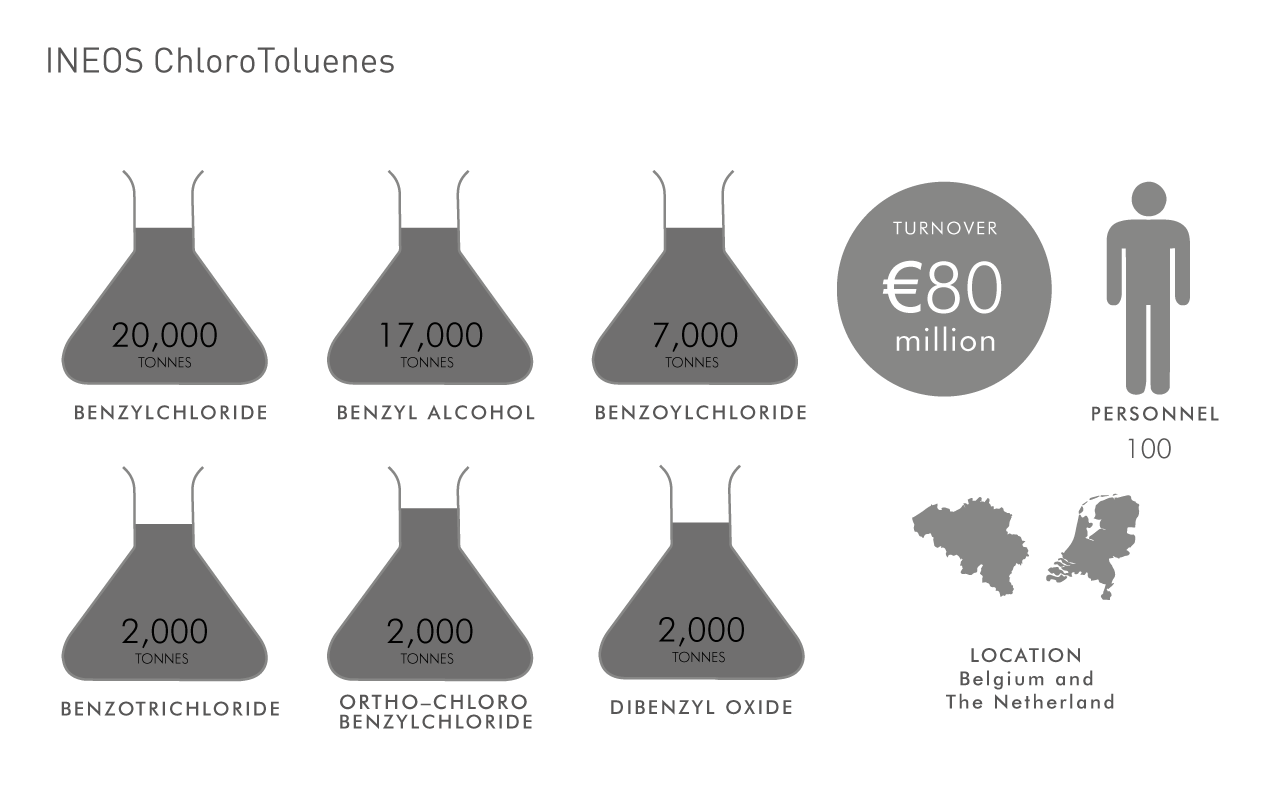
-
Chorus Of Approval
Safety is INEOS’ top priority. And everyone in the company knows it. But it’s always heart-warming when industry experts recognise what the company is striving to achieve – and publicly acknowledge it.
The voice of the chemical industry in France has named Petroineos as worthy winners of a prestigious national award for its innovative approach to caring for the well-being of its staff.
The Union des Industries Chimiques, The French trade association for the chemicals sector, presented the Lavera site with the Responsible Care award in the occupational health category for the way the company now prevents staff being exposed to certain products.
“The use of biological indicators of exposure in itself is not new,” said Jacques Willocquet, HSSE manager at the French site. “But in most cases it is limited to a yes/no response. What we have done is introduce a rigorous statistical analysis of thousands of results, which allows us to detect the slightest change so we know if a member of staff has been exposed to even a small amount.”
The award is presented every three years.
This year’s award ceremony coincided with the Journées de la Chimie, which meant the event was attended by many high-profile guests, including Arnaud Montebourg, France’s Industry Minister.
“Apart from the fact that the award reflects well on INEOS’ reputation in the petrochemical industry, it also shows the staff how tracking relentlessly weak signals is helping us to better care about their health,” said Jacques.
Petroineos beat 17 other companies to win the occupational health category.
Across the Atlantic, staff at INEOS’ O&P Battleground Manufacturing Complex (BMC) in Texas were also celebrating after picking up four awards at the Texas Chemical Council’s (TCC) annual awards.
The plant won the Caring for Texas Award, the Zero Contractor Incident Rate Award and the Distinguished Safety Service Award in recognition of its exemplary safety performance last year.
But the big award of the night went to Bob Bradshaw for his outstanding leadership skills in managing the plant safely.
He won The Gerald R. Ehrman Award for Management in honour of Jerry Ehrman, a retired plant manager of the Sabine River Works in Orange, Texas, who was extremely dedicated to occupational safety. The award is presented to just one site manager every year – if one merits it. But so far it has only been presented to two people in the past four years and one of those was Bob.
“The award is only given to a plant manager who embodies the same leadership and dedication to safety management as Mr Ehrman,” said Morgan French, BMC SSHE Manager. “Bob is unrelenting in his goal to make sure everyone who works at the site goes home at the end of their shift safely, every day. He demonstrates a genuine personal commitment to safety excellence and challenges everyone who works with him to attain a comparable level of personal safety excellence.”
-
Debate: Can Religion and Science Co-exist?
The late German-born physicist Albert Einstein believed that science without religion was lame, and religion without science was blind. But the debate over whether science and religion can co-exist has been going on since the dawn of mankind and continues to divide opinion even today, as INCH discovered.
-
I am convinced that evolution and religious beliefs need not be in contradiction. Indeed, if science and religion are properly understood, they cannot be in contradiction because they concern different matters. Science and religion are like two different windows for looking at the world. The two windows look at the same world, but they show different aspects of that world. Science concerns the processes that account for the natural world: how planets move, the composition of matter and the atmosphere, the origin and adaptations of organisms. Religion concerns the meaning and purpose of the world and of human life, the proper relation of people to the Creator and to each other, the moral values that inspire and govern people’s lives. Apparent contradictions only emerge when either the science or the beliefs, or often both, trespass their own boundaries and wrongfully encroach upon one another’s subject matter.
Francisco Ayala, biologist, University of California, Irvine -
Observe: science and religion *do* coexist. The first scientists were clergymen. Today, religious institutions from universities to the Vatican Observatory support professional science. And the proportion of scientists who are themselves believers mirrors the fraction in the general population. Science is based on the religious assertion that Creation is orderly, free from the interference of nature gods, and worthy of study. So who continues to push this myth of a “conflict”? What is their agenda?
Jesuit Brother Guy Consolmagno, astronomer at the Vatican Observatory -
Religion and science are like oil and water. They might co-exist, but they can never mix to produce a homogeneous medium. Religion and science are fundamentally incompatible. They disagree profoundly on how we obtain knowledge of the world. Science is based observation and reasoning from observation. Religion assumes that human beings can access a deeper level of information that is not available by either observation or reason. The scientific method is proven by its success. The religious method is refuted by its failure.
Victor J. Stenger, Emeritus Professor of Physics, University of Hawaii -
Personally I’m not religious at all, but I have religious scientists as friends and they seem to manage just fine. I think those people are more likely to take some religious things a bit less literally though, like a religious geologist probably wouldn’t think that the Earth and everything else was actually made by God 6000 years ago, since their science tells them that the Earth is 4.5 billion years old.
Grant Kennedy, astrophysicist, University of Cambridge -
Science and religion are not at odds. Science is simply too young to understand. Whether or not you believe in God, you must believe this: when we as a species abandon our trust in a power greater than us, we abandon our sense of accountability. Faiths, all faiths, are admonitions that there is something we cannot understand, something to which we are accountable. With faith we are accountable to each other, to ourselves, and to a higher truth. Religion is flawed, but only because man is flawed. Science tells me God must exist. My mind tells me I will never understand God. And my heart tells me I am not meant to.
Dan Brown, author of Angels & Demons -
Science is not only compatible with spirituality; it is a profound source of spirituality. When we recognise our place in an immensity of light-years and in the passage of ages, when we grasp the intricacy, beauty, and subtlety of life, then that soaring feeling, that sense of elation and humility combined, is surely spiritual. So are our emotions in the presence of great art or music or literature, or acts of exemplary selfless courage such as those of Mohandas Gandhi or Martin Luther King, Jr. The notion that science and spirituality are somehow mutually exclusive does a disservice to both.
The late Carl Sagan, American astrophysicist -
From religion comes a man’s purpose; from science, his power to achieve it. Sometimes people ask if religion and science are not opposed to one another. They are: in the sense that the thumb and fingers of my hands are opposed to one another. It is an opposition by means of which anything can be grasped.
The late William H. Bragg, British physicist -
Religion and science are indeed incompatible. Religion and science both offer explanations for why life and the universe exist. Science relies on testable empirical evidence and observation. Religion relies on subjective belief in a creator. Only one explanation is correct. The other must be discarded. Explanations require evidence. None exists for a creator outside the human mind, whereas the evidence for evolution and the origins of life mounts every day. In the face of this uncontradicted evidence, religious belief in a divinity is no more viable than belief in the now-proverbial Flying Spaghetti Monster.
Lorna Salzman, American environmental activist -
There is a fundamental difference between religion, which is based on authority, and science, which is based on observation and reason. Science will win because it works. I believe the universe is governed by the laws of science. The laws may have been decreed by God, but God does not intervene to break the laws. When you look at the vast size of the universe, and how insignificant and accidental human life is in it, the existence of a God seems most implausible.
Physicist Stephen Hawking
-
-
INEOS Joins The Revolution
INEOS has gone into partnership with a company that has developed a unique product which could help to save the rainforest.
INEOS Compounds will be using its expertise to help increase the company’s sales of Resysta, a recyclable material made primarily from rice husks and PVC that looks and feels like wood but, unlike wood, does not splinter, crack, rot, swell or fade.
“Japanese companies have been trying to mix rice husks and polymers since the 1960s but they have never come up with a sellable product,” said Roland Stoiber, chief operations officer at Resysta International.
INEOS Compounds’ Swiss site in Sins, near Lucerne, began working with Resysta International last year.
“Since then it has become the second biggest business for us at Sins,” said Managing Director Thomas Breitwieser who is championing the project.
Resysta International was won over by INEOS’ innovative approach, its ability to think and act quickly, its hard-working ethos, its knowledge of the European market, its excellent contacts and its manufacturing capabilities.
“We had a good relationship right from the beginning and we trusted each other to work hard together to build a market that is worth billions of Euros,” said Thomas.
INEOS Compounds, one of the top manufacturers of PVC compounds in Europe, will manufacture Resysta at its plants in the UK, Switzerland and Sweden and sell it directly to INEOS’ customers. It will also sell some of the raw materials, on behalf of Resysta International, to its biggest customers who may wish
to mix the chemicals themselves.“It is wonderful to be part of placing a brand new PVC-based product in the market,” said Thomas. “That sort of thing only happens maybe every 30 years because PVC is already the most field-tested plastic in the world. But we will be developing the product alongside Resysta International as new sales opportunities are unearthed. It has huge market potential.”
Leroy Merlin, one of the top five D-I-Y stores in France, recently named it as their product of the year.
The main ingredient of the material, which can be used in a huge range of ways in the construction and furniture industries, are rice husks which would otherwise be burned as a waste product in the Far East where it was first developed. The rice husks are then mixed with PVC components.
The trade in tropical hardwoods, such as mahogany and teak, has long been seen as a major reason for the destruction of the rainforests.
This changes all that.
“Some miracles happen and some are invented,” said Roland. “Even salt water, sun and wind, when other materials give up, Resysta carries on. This is the key innovation to what was needed to address the shrinking rainforests and the inferior quality of previous wood composite products. It has opened a new market to all PVC resin producers.”
-
INEOS To Buy Out BASF Stake In Styrolution
INEOS has agreed to buy out fellow chemical company BASF’s 50% stake in its styrene plastics joint venture for €1.1 billion.
The deal, subject to regulatory approval, will see INEOS take full control of Styrolution which makes plastics for cars, electronics, toy and the construction industry.
“We are pleased to bring Styrolution fully into the INEOS family,” said INEOS Capital chairman Jim Ratcliffe.
As part of the joint venture agreement signed in October 2011, INEOS always had the right to buy out BASF.
The joint venture had been set up to create a company that was capable of competing effectively with large-scale producers from Asia and the Middle East.
“Styrolution has fulfilled that promise,” said Jim.
Styrolution is the leading, global supplier of styrenics, which also ensure computer casings and monitors are strong and heat resistant. Four out of five printers in the world are produced with a casing made from Styrolution.
Today the business employees about 3,200 people worldwide at 17 manufacturing sites in 10 countries. Once the deal is completed, the business will operate as a standalone company within INEOS Industries Holdings Limited.
-
World Class Thinking
Innovation isn’t just about developing new products.
Sometimes it’s about just thinking differently, as INEOS did in 2009 and has now been publicly recognised for it.
At the 2nd annual Petrochemicals Awards of Excellence in Berlin, Germany, INEOS beat strong competition from industry giants DOW and BASF to win the prestigious award for its ‘outstanding contribution to the chemical industry’.
The award recognised INEOS’ ambitious and innovative plan to be the first company to ship ethane derived from shale gas from America to Europe to secure the long-term competitiveness of its European crackers.
“We are one of the very few who could have undertaken such a move,” said Fernando Mota, INEOS Feedstock, Energy & CO2 Manager. “We saw the opportunity early and moved quickly in this rapidly developing arena.”
The first shipments of gas will arrive next year, heralding an exciting new phase in the European petrochemicals industry and effectively moving INEOS’ crackers at Rafnes in Norway and Grangemouth in Scotland into pole position to compete.
-
European Commission Clears Way For Joint Venture With Solvay
INEOS and Solvay have signed a definitive Joint Venture Agreement to create a leading PVC Producer to be called INOVYN.
The two companies announced their plans to join forces in May last year but it took until May this year for the European Commission to approve the proposed joint venture.
Together they will have combined sales of 4.3 billion Euros, employ about 5,650 staff in nine countries and rank among the top three producers in the world.
But first they must implement an agreed remedy package for the divestment of five INEOS-owned assets – the membrane chlorine plant and EDC/ VCM plants at Tessenderlo, Belgium, the PVC plants in Mazingarbe, France, and Beek in the Netherlands, the PVC and VCM plants at Wilhelmshaven in Germany, and the British EDC plants in Runcorn.
The Commission also wants Runcorn’s membrane chlorine plant to be placed in a joint venture between the INEOS/ Solvay joint venture and the new owner of the five affected plants.
Once all that has been done, the JV can go-ahead.
“The newly combined business, which will be of world scale, will be able to better respond to rapidly changing European markets and to match increasing competition from global producers,” said INEOS chairman Jim Ratcliffe.
-
EPS Qatar Signs Deal With INEOS Technologies
INEOS has licensed its expandable polystyrene (EPS) technology to EPS Qatar for its planned complex in Qatar.
The plant, which will produce a wide range of expandable polystyrene grades to satisfy the growing regional demand, will be the biggest EPS unit in the Middle East and North Africa region.
EPS is a lightweight, strong thermoplastic product with excellent thermal insulation, which makes it ideal for the packaging and construction industries.
Initially the plant will be able to produce 50,000 tons per year but will have the capacity to double production.
-
INEOS’ Global Appeal
INEOS Technologies has agreed to supply four state-of-the-art BICHLOR™ bipolar electrolysers to HF Chlor-Alkali’s new manufacturing plant in the US state of Iowa.
Using INEOS’ technology, the new plant in Eddyville will be able to manufacture caustic soda, muriatic acid and bleach for an adjacent food processing facility and other Midwest facilities.
INEOS BICHLOR™ electrolysers have now been sold to 56 projects around the world.
The biggest plant using the technology is in Runcorn in the UK, where 20 BICHLOR™ electrolysers produce more than 1,000,000te of chlor-alkali products each year.
